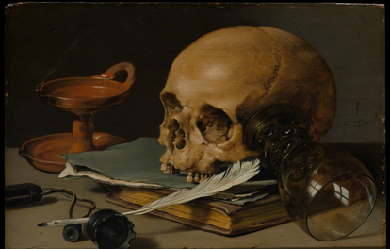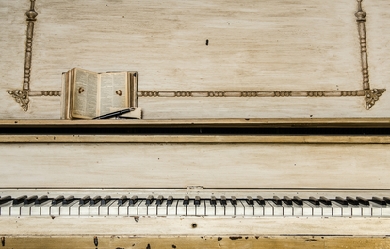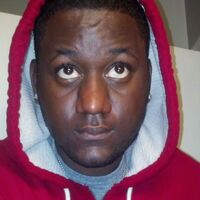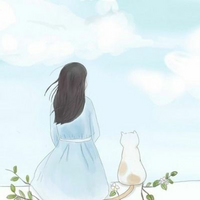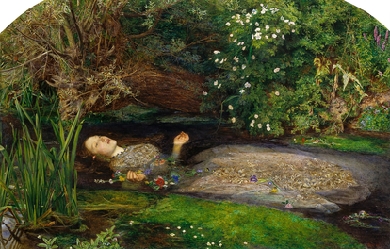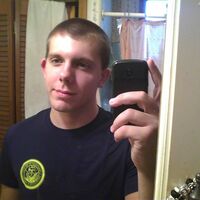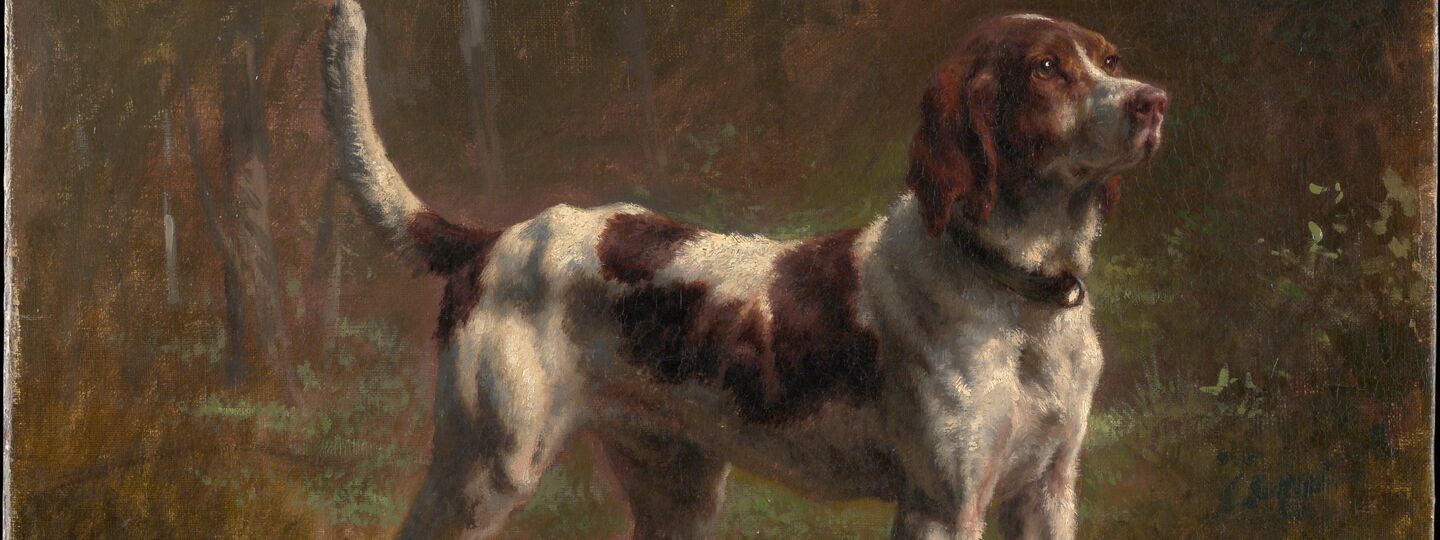
Info
A Limier Briquet Hound
Rosa Bonheur
1856
The Metropolitan Museum of Art
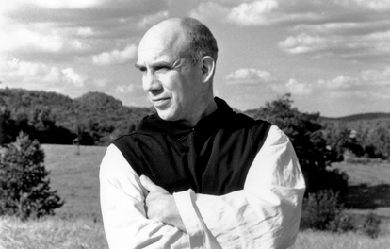
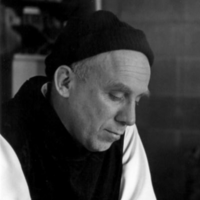
Thomas Merton (January 31, 1915 – December 10, 1968) was an American Trappist monk, writer, theologian, mystic, poet, social activist, and scholar of comparative religion. On May 26, 1949, he was ordained to the priesthood and given the name Father Louis.Merton wrote more than 70 books, mostly on spirituality, social justice and a quiet pacifism, as well as scores of essays and reviews. Among Merton’s most enduring works is his bestselling autobiography The Seven Storey Mountain (1948), which sent scores of World War II veterans, students, and even teenagers flocking to monasteries across the US, and was also featured in National Review’s list of the 100 best non-fiction books of the century. Merton was a keen proponent of interfaith understanding. He pioneered dialogue with prominent Asian spiritual figures, including the Dalai Lama, the Japanese writer D. T. Suzuki, the Thai Buddhist monk Buddhadasa, and the Vietnamese monk Thich Nhat Hanh, and authored books on Zen Buddhism and Taoism. In the years since his death, Merton has been the subject of several biographies.

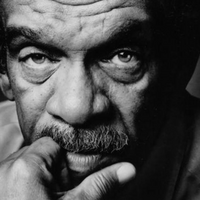
Sir Derek Alton Walcott, KCSL OBE OCC (born 23 January 1930) is a Saint Lucian–Trinidadian poet and playwright. He received the 1992 Nobel Prize in Literature. He is currently Professor of Poetry at the University of Essex. His works include the Homeric epic poem Omeros (1990), which many critics view “as Walcott’s major achievement.” In addition to having won the Nobel, Walcott has won many literary awards over the course of his career, including an Obie Award in 1971 for his play Dream on Monkey Mountain, a MacArthur Foundation “genius” award, a Royal Society of Literature Award, the Queen’s Medal for Poetry, the inaugural OCM Bocas Prize for Caribbean Literature, the 2011 T. S. Eliot Prize for his book of poetry White Egrets and the Griffin Trust For Excellence In Poetry Lifetime Recognition Award in 2015. Early life and education Walcott was born and raised in Castries, Saint Lucia, in the West Indies with a twin brother, the future playwright Roderick Walcott, and a sister, Pamela Walcott. His family is of African and European descent, reflecting the complex colonial history of the island which he explores in his poetry. His mother, a teacher, loved the arts and often recited poetry around the house. His father, who painted and wrote poetry, died at age 31 from mastoiditis while his wife was pregnant with the twins Derek and Roderick, who were born after his death. Walcott’s family was part of a minority Methodist community, who felt overshadowed by the dominant Catholic culture of the island established during French colonial rule. As a young man Walcott trained as a painter, mentored by Harold Simmons, whose life as a professional artist provided an inspiring example for him. Walcott greatly admired Cézanne and Giorgione and sought to learn from them. Walcott’s painting was later exhibited at the Anita Shapolsky Gallery in New York City, along with the art of other writers, in a 2007 exhibition named “The Writer’s Brush: Paintings and Drawing by Writers”. He studied as a writer, becoming “an elated, exuberant poet madly in love with English” and strongly influenced by modernist poets such as T. S. Eliot and Ezra Pound. Walcott had an early sense of a vocation as a writer. In the poem “Midsummer” (1984), he wrote: At 14, Walcott published his first poem, a Miltonic, religious poem in the newspaper, The Voice of St Lucia. An English Catholic priest condemned the Methodist-inspired poem as blasphemous in a response printed in the newspaper. By 19, Walcott had self-published his two first collections with the aid of his mother, who paid for the printing: 25 Poems (1948) and Epitaph for the Young: XII Cantos (1949). He sold copies to his friends and covered the costs. He later commented, I went to my mother and said, 'I’d like to publish a book of poems, and I think it’s going to cost me two hundred dollars.' She was just a seamstress and a schoolteacher, and I remember her being very upset because she wanted to do it. Somehow she got it—a lot of money for a woman to have found on her salary. She gave it to me, and I sent off to Trinidad and had the book printed. When the books came back I would sell them to friends. I made the money back. The influential Bajan poet Frank Collymore critically supported Walcott’s early work. With a scholarship, he studied at the University College of the West Indies in Kingston, Jamaica. Personal life Derek Walcott married Fay Moston, a secretary, but the marriage lasted only a few years and ended in divorce. Walcott married a second time to Margaret Maillard, who worked as an almoner in a hospital, but that also ended in divorce. In 1976, Walcott then married Norline Metivier, but this marriage also did not last. He has children named Elizabeth, Peter and Anna. Walcott is also known for his passion for traveling to different countries around the world. He splits his time between New York, Boston, and St. Lucia, where he incorporates the influences of different areas into his pieces of work. Career After graduation, Walcott moved to Trinidad in 1953, where he became a critic, teacher and journalist. Walcott founded the Trinidad Theatre Workshop in 1959 and remains active with its Board of Directors. Exploring the Caribbean and its history in a colonialist and post-colonialist context, his collection In a Green Night: Poems 1948–1960 (1962) attracted international attention. His play Dream on Monkey Mountain (1970) was produced on NBC-TV in the United States the year it was published. In 1971 it was produced by the Negro Ensemble Company off-Broadway in New York City; it won an Obie Award that year for “Best Foreign Play”. The following year, Walcott won an OBE from the British government for his work. He was hired as a teacher by Boston University in the United States, where he founded the Boston Playwrights’ Theatre in 1981. That year he also received a MacArthur Foundation Fellowship in the United States. Walcott taught literature and writing at Boston University for more than two decades, publishing new books of poetry and plays on a regular basis and retiring in 2007. He became friends with other poets, including the Russian Joseph Brodsky, who lived and worked in the US after being exiled in the 1970s, and the Irish Seamus Heaney, who also taught in Boston. His epic poem, Omeros (1990), which loosely echoes and refers to characters from The Iliad, has been critically praised “as Walcott’s major achievement.” The book received praise from publications such as The Washington Post and The New York Times Book Review, which chose the book as one of its "Best Books of 1990". Walcott was awarded the Nobel Prize in Literature in 1992, the second Caribbean writer to receive the honor after Saint-John Perse, who was born in Guadeloupe, received the award in 1960. The Nobel committee described Walcott’s work as “a poetic oeuvre of great luminosity, sustained by a historical vision, the outcome of a multicultural commitment.” He won an Anisfield-Wolf Book Award for Lifetime Achievement in 2004. His later poetry collections include Tiepolo’s Hound (2000), illustrated with copies of his watercolors; The Prodigal (2004), and White Egrets (2010), which received the T.S. Eliot Prize. In 2009, Walcott began a three-year distinguished scholar-in-residence position at the University of Alberta. In 2010, he became Professor of Poetry at the University of Essex. As a part of St Lucia’s Independence Day celebrations, in February 2016, he became one of the first knights of the Order of Saint Lucia, granting him the title of 'Sir’. Oxford Professor of Poetry candidacy In 2009, Walcott was a leading candidate for the position of Oxford Professor of Poetry. He withdrew his candidacy after reports of documented accusations against him of sexual harassment from 1981 and 1996. (The latter case was settled by Boston University out of court.) When the media learned that pages from an American book on the topic were sent anonymously to a number of Oxford academics, this aroused their interest in the university decisions. Ruth Padel, also a leading candidate, was elected to the post. Within days, The Daily Telegraph reported that she had alerted journalists to the harassment cases. Under severe media and academic pressure, Padel resigned. Padel was the first woman to be elected to the Oxford post, and journalists including Libby Purves, Yasmin Alibhai-Brown, the American Macy Halford and the Canadian Suzanne Gardner attributed the criticism of her to misogyny and a gender war at Oxford. They said that a male poet would not have been so criticized, as she had reported published information, not rumour. Numerous respected poets, including Seamus Heaney and Al Alvarez, published a letter of support for Walcott in The Times Literary Supplement, and criticized the press furore. Other commentators suggested that both poets were casualties of the media interest in an internal university affair, because the story “had everything, from sex claims to allegations of character assassination”. Simon Armitage and other poets expressed regret at Padel’s resignation. Writing Themes Methodism and spirituality have played a significant role from the beginning in Walcott’s work. He commented, “I have never separated the writing of poetry from prayer. I have grown up believing it is a vocation, a religious vocation.” Describing his writing process, he wrote, "the body feels it is melting into what it has seen… the 'I’ not being important. That is the ecstasy... Ultimately, it’s what Yeats says: ‘Such a sweetness flows into the breast that we laugh at everything and everything we look upon is blessed.’ That’s always there. It’s a benediction, a transference. It’s gratitude, really. The more of that a poet keeps, the more genuine his nature." He also notes, “if one thinks a poem is coming on... you do make a retreat, a withdrawal into some kind of silence that cuts out everything around you. What you’re taking on is really not a renewal of your identity but actually a renewal of your anonymity.” Influences Walcott has said his writing was influenced by the work of the American poets, Robert Lowell and Elizabeth Bishop, who were also friends. Playwriting He has published more than twenty plays, the majority of which have been produced by the Trinidad Theatre Workshop and have also been widely staged elsewhere. Many of them address, either directly or indirectly, the liminal status of the West Indies in the post-colonial period. Through poetry he also explores the paradoxes and complexities of this legacy. Essays In his 1970 essay “What the Twilight Says: An Overture”, discussing art and theatre in his native region (from Dream on Monkey Mountain and Other Plays), Walcott reflects on the West Indies as colonized space. He discusses the problems for an artist of a region with little in the way of truly indigenous forms, and with little national or nationalist identity. He states: “We are all strangers here... Our bodies think in one language and move in another". The epistemological effects of colonization inform plays such as Ti-Jean and his Brothers. Mi-Jean, one of the eponymous brothers, is shown to have much information, but to truly know nothing. Every line Mi-Jean recites is rote knowledge gained from the coloniser; he is unable to synthesize it or apply it to his life as a colonised person. Walcott notes of growing up in West Indian culture: “What we were deprived of was also our privilege. There was a great joy in making a world that so far, up to then, had been undefined... My generation of West Indian writers has felt such a powerful elation at having the privilege of writing about places and people for the first time and, simultaneously, having behind them the tradition of knowing how well it can be done—by a Defoe, a Dickens, a Richardson.” Walcott identifies as “absolutely a Caribbean writer”, a pioneer, helping to make sense of the legacy of deep colonial damage. In such poems as “The Castaway” (1965) and in the play Pantomime (1978), he uses the metaphors of shipwreck and Crusoe to describe the culture and what is required of artists after colonialism and slavery: both the freedom and the challenge to begin again, salvage the best of other cultures and make something new. These images recur in later work as well. He writes, “If we continue to sulk and say, Look at what the slave-owner did, and so forth, we will never mature. While we sit moping or writing morose poems and novels that glorify a non-existent past, then time passes us by.” Omeros Walcott’s epic book-length poem Omeros was published in 1990 to critical acclaim. The poem very loosely echoes and references Homer and some of his major characters from The Iliad. Some of the poem’s major characters include the island fishermen Achille and Hector, the retired English officer Major Plunkett and his wife Maud, the housemaid Helen, the blind man Seven Seas (who symbolically represents Homer), and the author himself. Although the main narrative of the poem takes place on the island of St. Lucia, where Walcott was born and raised, Walcott also includes scenes from Brookline, Massachusetts (where Walcott was living and teaching at the time of the poem’s composition), and the character Achille imagines a voyage from Africa onto a slave ship that is headed for the Americas; also, in Book Five of the poem, Walcott narrates some of his travel experiences in a variety of cities around the world, including Lisbon, London, Dublin, Rome, and Toronto. Composed in a variation on terza rima, the work explores the themes that run throughout Walcott’s oeuvre: the beauty of the islands, the colonial burden, the fragmentation of Caribbean identity, and the role of the poet in a post-colonial world. Criticism and praise Walcott’s work has received praise from major poets including Robert Graves, who wrote that Walcott “handles English with a closer understanding of its inner magic than most, if not any, of his contemporaries”, and Joseph Brodsky, who praised Walcott’s work, writing: “For almost forty years his throbbing and relentless lines kept arriving in the English language like tidal waves, coagulating into an archipelago of poems without which the map of modern literature would effectively match wallpaper. He gives us more than himself or 'a world’; he gives us a sense of infinity embodied in the language.” Walcott noted that he, Brodsky, and the Irish poet Seamus Heaney, who all taught in the United States, were a band of poets “outside the American experience”. The poetry critic William Logan critiqued Walcott’s work in a New York Times book review of Walcott’s Selected Poems. While he praised Walcott’s writing in Sea Grapes and The Arkansas Testament, he had mostly negative things to say about Walcott’s poetry, calling Omeros “clumsy” and Another Life “pretentious.”. Finally, he concluded with the faint praise that “No living poet has written verse more delicately rendered or distinguished than Walcott, though few individual poems seem destined to be remembered.” Most reviews of Walcott’s work are more positive. For instance, in The New Yorker review of The Poetry of Derek Walcott, Adam Kirsch had high praise for Walcott’s oeuvre, describing his style in the following manner: By combining the grammar of vision with the freedom of metaphor, Walcott produces a beautiful style that is also a philosophical style. People perceive the world on dual channels, Walcott’s verse suggests, through the senses and through the mind, and each is constantly seeping into the other. The result is a state of perpetual magical thinking, a kind of Alice in Wonderland world where concepts have bodies and landscapes are always liable to get up and start talking. He calls Another Life Walcott’s “first major peak” and analyzes the painterly qualities of Walcott’s imagery from his earliest work through to later books like Tiepolo’s Hound. He also explores the post-colonial politics in Walcott’s work, calling him “the postcolonial writer par excellence.” He calls the early poem “A Far Cry from Africa” a turning point in Walcott’s development as a poet. Like Logan, Kirsch is critical of Omeros which he believes Walcott fails to successfully sustain over its entirety. Although Omeros is the volume of Walcott’s that usual receives the most critical praise, Kirsch, instead believes that Midsummer is his best book. Awards and honours 1969 Cholmondeley Award 1971 Obie Award for Best Foreign Play (for Dream on Monkey Mountain) 1972 Officer of the Order of the British Empire 1981 MacArthur Foundation Fellowship ("genius award") 1988 Queen’s Gold Medal for Poetry 1990 Arts Council of Wales International Writers Prize 1990 W. H. Smith Literary Award (for poetry Omeros) 1992 Nobel Prize in Literature 2004 Anisfield-Wolf Book Award for Lifetime Achievement 2008 Honorary doctorate from the University of Essex 2011 T. S. Eliot Prize (for poetry collection White Egrets) 2011 OCM Bocas Prize for Caribbean Literature (for White Egrets) 2015 Griffin Trust For Excellence In Poetry Lifetime Recognition Award 2016 Knight Commander of the Order of Saint Lucia List of works * Works about Derek Walcott in libraries (WorldCat catalog) * Works by Derek Walcott at Open Library Further reading * Baer, William, ed. Conversations with Derek Walcott. Jackson: University Press of Mississippi, 1996. * Baugh, Edward, Derek Walcott: Memory as Vision: Another Life. London: Longman, 1978. * Baugh, Edward, Derek Walcott. Cambridge: Cambridge University Press, 2006. * Breslin, Paul, Nobody’s Nation: Reading Derek Walcott. Chicago: University of Chicago Press, 2001. ISBN 0-226-07426-9 * Brown, Stewart, ed., The Art of Derek Walcott. Chester Springs, PA.: Dufour, 1991; Bridgend: Seren Books, 1992. * Burnett, Paula, Derek Walcott: Politics and Poetics. Gainesville: University Press of Florida, 2001. * Fumagalli, Maria Cristina, The Flight of the Vernacular: Seamus Heaney, Derek Walcott and the Impress of Dante. Amsterdam-New York: Rodopi, 2001. * Fumagalli, Maria Cristina, Agenda 39:1–3 (2002–03), Special Issue on Derek Walcott. Includes Derek Walcott’s Epitaph for the Young (1949) republished here in its entirety. * Fumagalli, Maria Cristina and Patrick, Peter, “Two Healing Narratives: Suffering, Reintegration, and the Struggle of Language”, Small Axe 20 10:2 (2006), pp. 61–79. * Fumagalli, Maria Cristina, “Brushing History Against the Grain: Derek Walcott’s Tiepolo’s Hound”, in Caribbean Perspectives on Modernity: Returning Medusa’s Gaze. Charlottesville: University of Virginia Press, 2009. * Gazzoni, Andrea, Epica dell’arcipelago. Il racconto della tribù, Derek Walcott, “Omeros”. Firenze: Le Lettere, 2009. ISBN 88-6087-288-X * Hamner, Robert D., ed. Critical Perspectives on Derek Walcott. Washington, D.C.: Three Continents, 1993. ISBN 0-89410-142-0 * Hamner, Robert D., Derek Walcott. Updated Edition. Twayne’s World Authors Series. TWAS 600. New York: Twayne, 1993. * Heaney, Seamus, “The Murmur of Malvern”, in The Government of the Tongue: The 1986 T. S. Eliot Memorial Lectures and Other Critical Writings. London: Faber and Faber, 1988, pp. 23–29. * King, Bruce, Derek Walcott and West Indian Drama: “Not Only a Playwright But a Company”: The Trinidad Theatre Workshop 1959–1993. Oxford: Clarendon Press, 1995. * King, Bruce, Derek Walcott, A Caribbean Life. Oxford: Oxford University Press, 2000. * Lennard, John, “Derek Walcott”, in Jay Parini, ed., World Writers in English. 2 vols, New York & London: Charles Scribner’s Sons, 2004, II.721–46. * Morris, Mervyn, “Derek Walcott”, in Bruce King, ed., West Indian Literature, Macmillan, 1979, pp. 144–60. * Parker, Michael and Roger Starkey, eds. New Casebooks: Postcolonial Literatures: Achebe, Ngugi, Desai, Walcott. Houndmills, Basingstoke, Hampshire: Macmillan, 1995. ISBN 0-333-60801-1 * Sinnewe, Dirk, Divided to the Vein? Derek Walcott’s Drama and the Formation of Cultural Identities. Saarbrücken: Königshausen und Neumann, 2001 [Reihe Saarbrücker Beiträge 17]. ISBN 3-8260-2073-1 * Terada, Rei, Derek Walcott’s Poetry: American Mimicry. Boston: Northeastern University Press, 1992. * Thieme, John, Derek Walcott. Manchester and New York: Manchester University Press, 1999. * Walcott, Derek, Dream on Monkey Mountain and Other Plays. New York: Farrar, 1970. ISBN 0-374-50860-7 References Wikipedia—https://en.wikipedia.org/wiki/Derek_Walcott
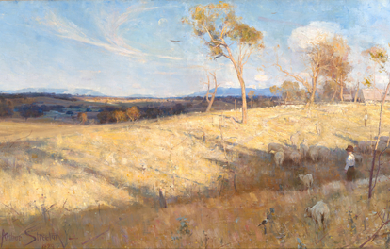
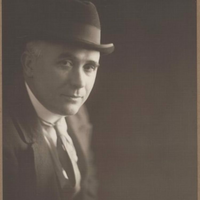
Edward George Dyson (4 March 1865– 22 August 1931) was an Australian journalist, poet, playwright and short story writer. He was the elder brother of talented illustrators Will Dyson and Ambrose Dyson. At 19, he began writing verse and, a few years later, embarked on a life of freelance journalism which lasted until his death. In 1896 he published a volume of poems, Rhymes from the Mines and, in 1898, the first collection of his short stories, Below and On Top.
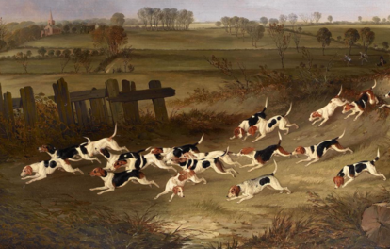
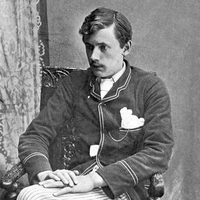
Ernest Christopher Dowson (2 August 1867– 23 February 1900) was an English poet, novelist, and short-story writer, often associated with the Decadent movement. He was born in Lee, London, in 1867. His great-uncle was Alfred Domett, a poet and politician who became Premier of New Zealand and had allegedly been the subject of Robert Browning’s poem “Waring.” Dowson attended The Queen’s College, Oxford, but left in March 1888 before obtaining a degree.
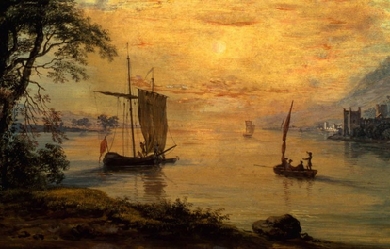

William Henry Davies or W. H. Davies (3 July 1871 – 26 September 1940) was a Welsh poet and writer. Davies spent a significant part of his life as a tramp or hobo, in the United Kingdom and United States, but became one of the most popular poets of his time. The principal themes in his work are observations about life's hardships, the ways in which the human condition is reflected in nature, his own tramping adventures and the various characters he met. Davies is usually considered one of the Georgian Poets, but much of his work is not typical in style or theme of the group. Early Life The son of an iron moulder, Davies was born at 6, Portland Street in the Pillgwenlly district of Newport, Monmouthshire, Wales, a busy port. He had an older brother, Francis Gomer Boase (who was considered "slow") and in 1874 his younger sister Matilda was born. In November 1874, when William was aged three, his father died. The following year his mother Mary Anne Davies remarried and became Mrs Joseph Hill. She agreed that care of the three children should pass to their paternal grandparents, Francis and Lydia Davies, who ran the nearby Church House Inn at 14, Portland Street. His grandfather Francis Boase Davies, originally from Cornwall, had been a sea captain. Davies was related to the famous British actor Sir Henry Irving (referred to as cousin Brodribb by the family); he later recalled that his grandmother referred to Irving as " the cousin who brought disgrace on us". Davies' grandmother was described, by a neighbour who remembered her, as wearing ".. pretty little caps, with bebe ribbon, tiny roses and puce trimmings". Writing in his Introduction to the 1943 Collected Poems of W. H. Davies, Osbert Sitwell recalled Davies telling him that, in addition to his grandparents and himself, his home consisted of "an imbecile brother, a sister ... a maidservant, a dog, a cat, a parrot, a dove and a canary bird." Sitwell also recounts that Davies' grandmother, a Baptist by denomination, was "of a more austere and religious turn of mind than her husband." In 1879 the family moved to Raglan Street, then later to Upper Lewis Street, from where William attended Temple School. In 1883 he moved to Alexandra Road School and the following year was arrested, as one of a gang of five schoolmates, and charged with stealing handbags. He was given twelve strokes of the birch. In 1885 Davies wrote his first poem entitled "Death". In his Poet's Pilgrimage (1918) Davies recounts the time when, at the age of 14, he was left with orders to sit with his dying grandfather. He missed the final moments of his grandfather's death as he was too engrossed in reading "a very interesting book of wild adventure". Delinquent to Supertramp Having finished school under the cloud of his theft he worked first for an ironmonger. In November 1886, his grandmother signed the papers for Davies to begin a five-year apprenticeship to a local picture-frame maker. Davies never enjoyed the craft, however, and never settled into any regular work. He was a difficult and somewhat delinquent young man, and made repeated requests to his grandmother to lend him the money to sail to America. When these were all refused, he eventually left Newport, took casual work and started to travel. The Autobiography of a Super-Tramp, published in 1908, covers his life in the USA between 1893 and 1899, including many adventures and characters from his travels as a drifter. During this period he crossed the Atlantic at least seven times, working on cattle ships. He travelled through many of the states, sometimes begging, sometimes taking seasonal work, but often ending up spending any savings on a drinking spree with a fellow traveller. He took advantage of the corrupt system of "boodle", in order to pass the winter in Michigan, by agreeing to be locked up in a series of different jails. Here, with his fellow tramps, Davies would enjoy the relative comfort of "card-playing, singing, smoking, reading, relating experiences and occasionally taking exercise or going out for a walk." At one stage, on his way to Memphis, Tennessee, he lay alone in a swamp for three days and nights suffering from malaria. The turning point in Davies' life came when, after a week of rambling in London, he spotted a newspaper story about the riches to be made in the Klondike and immediately set off to make his fortune in Canada. Attempting to jump a freight train at Renfrew, Ontario, on 20 March 1899, with fellow tramp Three-fingered Jack, he lost his footing and his right foot was crushed under the wheels of the train. The leg later had to be amputated below the knee and he wore a wooden leg thereafter. Davies' biographers have agreed that the significance of the accident should not be underestimated, even though Davies himself played down the story. Moult begins his biography with the incident and Stonesifer has suggested that this event, more than any other, led Davies to become a professional poet. Davies himself wrote of the accident: "I bore this accident with an outward fortitude that was far from the true state of my feelings. Thinking of my present helplessness caused me many a bitter moment, but I managed to impress all comers with a false indifference… I was soon home again, having been away less than four months; but all the wildness had been taken out of me, and my adventures after this were not of my own seeking, but the result of circumstances." Davies' view of his own disability was ambivalent. In his poem "The Fog", published in the 1913 Foliage, a blind man leads the poet through the fog, showing the reader that one who is handicapped in one domain may well have a considerable advantage in another. Poet He returned to Britain, living a rough life, particularly in London shelters and doss-houses, including the Salvation Army hostel in Southwark known as "The Ark" which he grew to despise. Fearing the contempt of his fellow tramps, he would often feign slumber in the corner of his doss-house, mentally composing his poems and only later committing them to paper in private. At one stage he borrowed money to have his poems printed on loose sheets of paper, which he then tried to sell door-to-door through the streets of residential London. When this enterprise failed, he returned to his lodgings and, in a fit of rage, burned all of the printed sheets in the fire. Davies self-published his first book of poetry, The Soul's Destroyer, in 1905, again by means of his own savings. It proved to be the beginning of success and a growing reputation. In order to even get the slim volume published, Davies had to forgo his allowance and live the life of a tramp for six months (with the first draft of the book hidden in his pocket), just to secure a loan of funds from his inheritance. When eventually published, the volume was largely ignored and he resorted to posting individual copies by hand to prospective wealthy customers chosen from the pages of Who's Who, asking them to send the price of the book, a half crown, in return. He eventually managed to sell 60 of the 200 copies printed. One of the copies was sent to Arthur Adcock, then a journalist with the Daily Mail. On reading the book, as he later wrote in his essay "Gods Of Modern Grub Street", Adcock said that he "recognised that there were crudities and even doggerel in it, there was also in it some of the freshest and most magical poetry to be found in modern books". He sent the price of the book and asked Davies to meet him. Adcock is still generally regarded as "the man who discovered Davies". The first trade edition of The Soul's Destroyer was published by Alston Rivers in 1907. A second edition followed in 1908 and a third in 1910. A 1906 edition, by Fifield, was advertised but has not been verified. Rural life in Kent On 12 October 1905 Davies met Edward Thomas, then literary critic for the Daily Chronicle in London, who was to do more to help him than anyone else. Thomas rented for Davies the tiny two-roomed "Stidulph's Cottage", in Egg Pie Lane, not far from his own home at Elses Farm near Sevenoaks in Kent. Davies moved to the cottage, from 6 Llanwern Street, Newport, via London, in the second week of February 1907. The cottage was "only two meadows off" from Thomas' own house. Thomas adopted the role of protective guardian for Davies, on one occasion even arranging for the manufacture, by a local wheelwright, of a makeshift replacement wooden leg, which was invoiced to Davies as "a novelty cricket bat". In 1907, the manuscript of The Autobiography of a Super-Tramp drew the attention of George Bernard Shaw, who agreed to write a preface (largely through the concerted efforts of his wife Charlotte). It was only because of Shaw that Davies' contract with the publishers was rewritten to allow the author to retain the serial rights, all rights after three years, royalties of fifteen per cent of selling price and a non-returnable advance of twenty five pounds. Davies was also to be given a say on the style of all illustrations, advertisement layouts and cover designs. The original publisher, Duckworth and Sons, refused to accept these demands and so the book was placed instead with London publisher Fifield. A number of anecdotes of Davies' time with the Thomas family in Kent are recounted in the brief account later published by Thomas' widow Helen. In 1911, Davies was awarded a Civil List Pension of £50, later increased to £100 and then again to £150. Davies started to spend more time in London and made many literary friends and acquaintances. Though averse to giving autographs himself, Davies began to make a collection of his own and was particularly keen to obtain that of D. H. Lawrence. Georgian poetry publisher Edward Marsh was able to secure an autograph and also invited Lawrence and wife-to-be Frieda to meet Davies on 28 July 1913. Lawrence was immediately captivated by Davies and later invited him to join them in Germany. Despite his early enthusiasm for Davies' work, however, Lawrence's opinion changed after reading Foliage and he commented after reading Nature Poems in Italy that the verses seemed "so thin, one can hardly feel them". By this time Davies had amassed a library of about fifty books in his cottage, mostly of 16th- and 17th-century poets, and including Shakespeare, Milton, Wordsworth, Byron, Burns, Shelley, Keats, Coleridge, Blake and Herrick. In December 1908 his essay "How It Feels To Be Out of Work", described by Stonesifer as "a rather pedestrian performance", appeared in the pages of The English Review. He continued to send other periodical articles out to editors, but without any success. Society life in London After lodging at a number of temporary addresses in Sevenoaks, Davies moved back to London early in 1914, settling eventually at 14 Great Russell Street in the Bloomsbury district, previously the residence of Charles Dickens. Here in a tiny two-room apartment, initially infested with mice and rats, and next door to rooms occupied by a noisy Belgian prostitute, he lived from early 1916 until 1921. It was during this time in London that Davies embarked on a series of public readings of his work, alongside such others as Hilaire Belloc and W. B. Yeats, impressing such fellow poets as Ezra Pound. He soon found that he was able to socialise with leading society figures of the day, including Lord Balfour and Lady Randolph Churchill. While in London Davies also became friendly with a number of artists, including Jacob Epstein, Harold and Laura Knight, Nina Hamnett, Augustus John, Harold Gilman, William Rothenstein, Walter Sickert, Sir William Nicholson and Osbert and Edith Sitwell. He enjoyed the society of literary men and their conversation, particularly in the rarefied atmosphere downstairs at the Café Royal. He would also meet regularly with W. H. Hudson, Edward Garrett and others at The Mont Blanc in Soho. In his poetry Davies drew extensively for material on his experiences with the seamier side of life, but also on his love of nature. By the time of his prominent place in the Edward Marsh Georgian Poetry series, he was an established figure. He is generally best known for the opening two lines of the poem "Leisure", first published in Songs Of Joy and Others in 1911: "What is this life if, full of care / We have no time to stand and stare..." In October 1917 his work was included in the anthology Welsh Poets: A Representative English selection from Contemporary Writers collated by A. G. Prys-Jones and published by Erskine Macdonald of London. In the last months of 1921, Davies moved to more comfortable quarters at 13 Avery Row, Brook Street, where he rented rooms from the Quaker poet Olaf Baker. He began to find prolonged work difficult, however, suffering from increased bouts of rheumatism and other ailments. Harlow (1993) lists a total of 14 BBC broadcasts of Davies reading his own work made between 1924 and 1940 (now held in the BBC broadcast archive) although none included his most famous work, "Leisure". Later Days, the 1925 sequel to The Autobiography of a Super-Tramp, describes the beginnings of Davies' career as a writer and his acquaintance with Belloc, Shaw and de la Mare, amongst many others. He became "the most painted literary man of his day", drawn and painted by Augustus John, Sir William Nicholson, Dame Laura Knight and Sir William Rothenstein. His head in bronze was the most successful of Epstein's smaller works. Honours, memorials and legacy In 1926 Davies was honoured with the degree of Doctor Litteris, honoris causa from the University of Wales. Davies returned to his native Newport in 1930, where a luncheon was held in his honour at the Westgate Hotel. His return, in September 1938, for the unveiling of the plaque in his honour, proved to be his last public appearance. A large collection of Davies manuscripts, including a copy of "Leisure", dated 8 May 1914, is held by the National Library of Wales. The collection includes a copy of "A Boy's Sorrow", an apparently unpublished poem of two eight-line stanzas relating to the death of a neighbour. Also included is a volume (c. 1916) containing autograph fair copies of 15 Davies poems, some of them apparently unpublished, submitted to James Guthrie (1874–1952) for publication by the Pear Tree Press as a collection entitled Quiet Streams, to which annotations have been added by Lord Kenyon. British writer Gerald Brenan (1894–1987) and his generation were influenced by Davies' Autobiography of a Super-Tramp. In 1951 Jonathan Cape published The Essential W. H. Davies, selected and with an introduction by Brian Waters, a young Gloucestershire poet and writer whose work Davies admired, who described him as "about the last of England's professional poets". The collection included The Autobiography of a Super-tramp, and extracts from Beggars, A Poet's Pilgrimage, Later Days, My Birds and My Garden, as well as over 100 poems arranged by publication period. Many of Davies' poems have been given a musical setting. "Money, O!" was set to music for piano, in G minor, by Michael Head - his 1929 Boosey & Hawkes collection also included settings for "The Likeness", "The Temper of a Maid", "Natures' Friend", "Robin Redbreast" and "A Great Time". There are also three songs by Sir Arthur Bliss - "Thunderstorms", "This Night", and "Leisure" - as well as "The Rain" for voice and piano, by Margaret Campbell Bruce, published in 1951 by J. Curwen and Sons. Experimental Irish folk group Dr Strangely Strange also sang and quoted from "Leisure" on their 1970 album Heavy Petting, with harmonium accompaniment. A musical adaptation of the same poem, with John Karvelas (vocals) and Nick Pitloglou (piano) and an animated film by Pipaluk Polanksi, may be found on YouTube. Also in 1970, Fleetwood Mac recorded "Dragonfly", a song with lyrics taken from Davies' 1927 poem, "The Dragonfly". The song was also recorded by English singer-songwriter and multi-instrumentalist Blake, for his 2011 album The First Snow. On 1 July 1971 a special First Day Cover, with a matching commemorative post-mark was issued by the UK Post Office to mark Davies' centenary. A controversial statue by Paul Bothwell-Kincaid, inspired by the poem "Leisure", was unveiled in Commercial Street, Newport in December 1990, to commemorate Davies' work, on the 50th anniversary of his death. The bronze head of Davies by Epstein, from January 1917, regarded by many as the most accurate artistic impression of Davies and a copy of which Davies owned himself, may be found at Newport Museum and Art Gallery (donated by Viscount Tredegar). In August 2010 the play Supertramp, Sickert and Jack the Ripper by Lewis Davies, concerning an imagined sitting by Davies for a portrait by Walter Sickert, premiered at the Edinburgh Festival. References Wikipedia—https://en.wikipedia.org/wiki/W._H._Davies

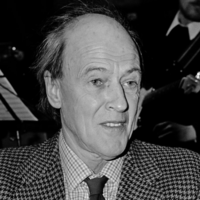
Roald Dahl was a British novelist, short story writer, poet, screenwriter, and fighter pilot. His books have sold over 200 million copies worldwide. Born in Wales to Norwegian parents, Dahl served in the Royal Air Force during the Second World War, in which he became a flying ace and intelligence officer, rising to the rank of acting wing commander. He rose to prominence in the 1940s with works for both children and adults and he became one of the world’s best-selling authors. He has been referred to as "one of the greatest storytellers for children of the 20th century". His awards for contribution to literature include the 1983 World Fantasy Award for Life Achievement, and the British Book Awards’ Children’s Author of the Year in 1990. In 2008, The Times placed Dahl 16th on its list of "The 50 greatest British writers since 1945".

my name shaqueria and poetry is my life i write all the time . its a way of expressing myself and my inner feelings i mostly write about reality and the real world like things thats goes on in life. really looking forward to making this writing my carreer, i write songs lyrics books and poetry of course im a nice outgoing person and my life is bascally in my poetry I dont really know how to speak or explain how i feel inless im putting it in words, my writing is my life i started when i was 10 i use to always rap and sing bt poetry found its way to my heart and stayed there i like reading other people poetry to see if there words could relate to mind. i was scared for the longest to put anything i wrote up because i thought people would judge me and i want get no where but to be judges put you in the right spot and actually open up your opp. because someone out there would like what you can created. i found out you would be rejected by some but it could also change someones life by my story and im hoping to. ill like you yall would leave some feedback on my poems tell me whats right whats wrong and how yall feel about what i have writing ..........THANK YOUU
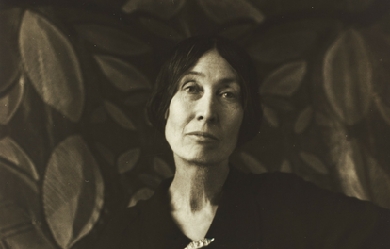
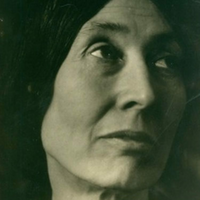
Lola Ridge, born Rose Emily Ridge (12 December 1873 Dublin—19 May 1941 Brooklyn) was an Irish-American anarchist poet and an influential editor of avant-garde, feminist, and Marxist publications. She is best remembered for her long poems and poetic sequences, published in numerous magazines and collected in five books of poetry. Along with other political poets of the early Modernist period, Ridge has received renewed critical attention since the beginning of the 21st century and is praised for making poetry directly from harsh urban life. A new selection of her poetry was published in 2007 and a biography in 2016.

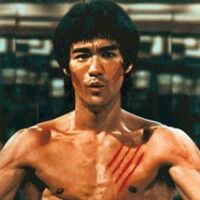
Bruce Jun Fan Lee was born in the hour of the Dragon, between 6 and 8 a.m., in the year of the Dragon on November 27, 1940 at the Jackson Street Hospital in San Francisco’s Chinatown. Today, a plaque in the hospital’s entry commemorates the place of his birth. Bruce’s birth, in the hour and the year of the Dragon, is a powerful symbol in Chinese astrology. It would be a strong omen of the powerful life that was to be lived by Bruce Lee and the explosive impact his life would have on countless others. Bruce was the fourth child born to Lee Hoi Chuen and his wife Grace Ho. He had two older sisters, Phoebe and Agnes, an older brother, Peter, and a younger brother, Robert. Lee Hoi Chuen was, by profession, a comedian in the Chinese opera and an actor in Cantonese films. At the time Bruce was born, Mr. and Mrs. Lee were on tour with the opera company in the United States. Thus, it was fortuitous for Bruce’s future that his birth took place in America, as he would return 18 years later to claim his birthright of American citizenship. Bruce’s parents gave him the name “Jun Fan.” Since it is Chinese custom to put the surname first, Bruce’s full name is written Lee Jun Fan. The true meaning of Jun Fan deserves an explanation as it, too, would foretell the journey of the newly born Lee son. Literally, JUN means “to arouse to the active state” or “to make prosperous.” It was a common middle name used by Hong Kong Chinese boys in those days, understandably because China and the Chinese people were very vulnerable at that time, and everyone, including Bruce’s parents, wanted the “sleeping lion of the East” to wake up. The FAN syllable refers to the Chinese name for San Francisco, but its true meaning is “fence of a garden” or “bordering subordinate countries of a big country.” During the period of the Ching Dynasty (1644-1911), many Chinese immigrated to Hawaii and San Francisco as laborers, and the implication became that the United States was FAN of the Great Ching Empire. Thus the true meaning of Bruce’s name--JUN FAN--was “to arouse and make FAN (the United States) prosperous.” The gut feeling of many Chinese at that time, who felt suppressed by and inferior to foreign powers, was that they wished to outshine the more superior countries and regain the Golden Age of China. Bruce’s parents wanted Bruce to have his name shine and shake the foreign countries, which he certainly succeeded in doing. The English name, BRUCE, was given to the baby boy by a nurse in the Jackson Street Hospital although he was never to use this name until he entered secondary school and began his study of the English language. The story goes that on the first day of English class, the students were asked to write down their English names, and Bruce, not knowing his name, copied the name of the student next to him. His family almost never used the name Bruce, especially in his growing up years when his nickname in the family was “SAI FON,” which literally means Little Peacock. This is a girl’s nickname, but in being applied to Bruce, it had a serious purpose. The first-born child of Mr. and Mrs. Lee had been a boy who did not survive infancy. Their belief was that if the gods did not favor the birth of a male child, the babe might be taken away. Thus, the name, Little Peacock, was used as a ruse to fool the gods into thinking that Bruce was a girl. It was a term of great affection within the family circle. At the age of three months, Lee Hoi Chuen, his wife Grace and baby Bruce returned to Hong Kong where Bruce would be raised until the age of 18. Probably because of the long ocean voyage and the change in climates, Bruce was not a strong child in his very early years, a condition that would change when he took up the study of gung fu at the age of 13. (Bruce always spelled his Chinese martial art as GUNG FU, which is the Cantonese pronunciation of the more commonly spelled Kung Fu, a Mandarin pronunciation.) Bruce’s most prominent memory of his early years was the occupation of Hong Kong by the Japanese during the World War II years (1941-1945). The residence of the Lee family was a flat at 218 Nathan Road in Kowloon directly across the street from the military encampment of the Japanese. Bruce’s mother often told the story of young Bruce, less than 5 years old, leaning precariously off the balcony of their home raising his fist to the Japanese Zeros circling above. Another nickname the family often applied to Bruce was “Mo Si Ting” which means “never sits still” and aptly described his personality. The Japanese occupation was Bruce’s first prescient memory, but Hong Kong had been a British Crown Colony since the late 1800’s. The English returned to power at the end of the war. It is not hard to see why young Bruce would have rebellious feelings toward foreign usurpation of his homeland. In his teenage years Bruce was exposed to the common practice of unfriendly taunting by English school boys who appeared to feel superior to the Chinese. It is not surprising that Bruce and his friends retaliated by returning the taunts and sometimes getting into fights with the English boys. This atmosphere laid the background for Bruce to begin his study of martial arts. At the age of 13, Bruce was introduced to Master Yip Man, a teacher of the Wing Chun style of gung fu. For five years Bruce studied diligently and became very proficient. He greatly revered Yip Man as a master teacher and wise man and frequently visited with him in later years. When he first took up gung fu, he used his new skills to pummel his adversaries, but it did not take long for Bruce to learn that the real value of martial arts training is that the skills of physical combat instill confidence to the point that one does not feel the constant need to defend one’s honor through fighting. In high school, Bruce, now no longer a weak child, was beginning to hone his body through hard training. One of his accomplishments was winning an interschool Boxing Championship against an English student in which the Marquis of Queensbury rules were followed and no kicking was allowed. Given the graceful movements, which would later be spectacularly displayed in his films, it is no surprise that Bruce was also a terrific dancer, and in 1958 he won the Hong Kong Cha Cha Championship. He studied dancing as assiduously as he did gung fu, keeping a notebook in which he had noted 108 different cha cha steps. It is easy to see that Bruce possessed the traits of self-discipline and hard work which would later hold him in good stead, even though at this stage he was not among the best academic students in the class. In addition to his studies, gung fu and dancing, Bruce had another side interest during his school years. He was a child actor under the tutelage of his father who must have known from an early age that Bruce had a streak of showmanship. Bruce’s very first role was as a babe in arms as he was carried onto the stage. By the time he was 18, he had appeared in 20 films. In those days movie making was not particularly glamorous or remunerative in Hong Kong, but Bruce loved acting. His mother often told stories of how Bruce was impossible to wake up to go to school, but just a tap on the shoulder at midnight would rouse him from his bed to go to the film studio. Movies were most often made at night in Hong Kong in order to minimize the sounds of the city. (See Filmography) At the age of 18, Bruce was looking for new vistas in his life, as were his parents who were discouraged that Bruce had not made more progress academically. It was common practice for high school graduates to go overseas to attend colleges, but that required excellent grades. Bruce’s brother and sister had come to the United States on student visas for their higher education. Although Bruce had not formally graduated from high school, and was more interested in gung fu, dancing and acting, his family decided that it was time for him to return to the land of his birth and find his future there. In April of 1959, with $100 in his pocket, Bruce boarded a steamship in the American Presidents Line and began his voyage to San Francisco. His passage was in the lower decks of the ship, but it didn’t take long for Bruce to be invited up to the first class accommodations to teach the passengers the cha cha. Landing in San Francisco, Bruce was armed with the knowledge that his dancing abilities might provide him a living, so his first job was as a dance instructor. One of his first students was Bob Lee, brother of James Y. Lee, who would become Bruce’s great friend, colleague in the martial arts, and eventually partner and Assistant Instructor of the Oakland Jun Fan Gung Fu Institute. Bruce did not stay long in San Francisco, but traveled to Seattle where a family friend, Ruby Chow, had a restaurant and had promised Bruce a job and living quarters above the restaurant. By now Bruce had left his acting and dancing passions behind and was intent on furthering his education. He enrolled at Edison Technical School where he fulfilled the requirements for the equivalent of high school graduation and then enrolled at the University of Washington. Typical of his personality traits, he attacked learning colloquial English as he had his martial arts training. Not content to speak like a foreigner, he applied himself to learning idiosyncrasies of speech. His library contained numerous books, underlined and dog-eared on common English idiomatic phrases. Although he never quite lost the hint of an English accent when speaking, his ability to turn a phrase or “be cool” was amazing for one who did not speak a word of the language until the age of 12. Bruce’s written English skills exceeded his spoken language abilities at first because he had been well tutored in the King’s proper English prose in Hong Kong. When his wife-to-be met him at the University of Washington, he easily edited her English papers for correct grammar and syntax. At the university, Bruce majored in philosophy. His passion for gung fu inspired a desire to delve into the philosophical underpinnings of the arts. Many of his written essays during those years would relate philosophical principles to certain martial arts techniques. For instance, he wrote often about the principles of yin and yang and how they could translate into hard and soft physical movements. In this way he was completing his education as a true martial artist in the time-honored Chinese sense of one whose knowledge encompasses the physical, mental and spiritual aspects of the arts. In the three years that Bruce studied at the university, he supported himself by teaching gung fu, having by this time given up working in the restaurant, stuffing newspapers or various other odd jobs. He and a few of his new friends would meet in parking lots, garages or any open space and play around with gung fu techniques. In the late ‘50’s and early ‘60’s, “gung fu” was an unknown term; in fact, the only physical art that might be listed in the yellow pages was Judo. Even the name “karate” was not a familiar term. The small group of friends was intrigued by this art called gung fu. One of the first students in this group was Jesse Glover who continues to teach some of Bruce’s early techniques to this day. It was during this period that Bruce and Taky Kimura became friends. Not only would Taky become Bruce’s gung fu student and the first Assistant Instructor he ever had, but the friendship forged between the two men was a source of love and strength for both of them. Taky Kimura has continued to be Bruce’s staunch supporter, devoting endless hours to preserving his art and philosophy throughout the 30 years since Bruce’s passing. The small circle of friends that Bruce had made encouraged him to open a real school of gung fu and charge a nominal sum for teaching in order to support himself while attending school. Renting a small basement room with a half door entry from 8th Street in Seattle’s Chinatown, Bruce decided to call his school the Jun Fan Gung Fu Institute. In 1963, having established a dedicated group of students and having given numerous demonstrations at the university, Bruce thought he might attract more students by opening a larger school at 4750 University Way where he also lived in a small room in the back of the kwoon. One of his students in 1963 was a freshman at the University of Washington, Linda Emery. Linda knew who Bruce was from his guest lectures in Chinese philosophy at Garfield High School, and in the summer after graduating, at the urging of her Chinese girlfriend, SueAnn Kay, Linda started taking gung fu lessons. It wasn’t long before the instructor became more interesting than the lessons. Bruce and Linda were married in 1964. By this time, Bruce had decided to make a career out of teaching gung fu. His plan involved opening a number of schools around the country and training assistant instructors to teach in his absence. Leaving his Seattle school in the hands of Taky Kimura, Bruce and Linda moved to Oakland where Bruce opened his second school with James Lee. The two men had formed a friendship over the years with each traveling frequently between Seattle and Oakland. James was a gung fu man from way back, but when he saw Bruce’s stuff he was so impressed that he wanted to join with him in starting a school. Thus the second branch of the Jun Fan Gung Fu Institute was founded. Having now been in the United States for five years, Bruce had left behind any thought of acting as a career, and devoted himself completely to his choice of martial arts as a profession. Up to this time Bruce’s gung fu consisted mostly of wing chun techniques and theory he had learned from Yip Man. Gradually though, because of his burgeoning interest in the philosophy of martial arts and his desire for self improvement, he was expanding his repertoire. A particular incident accelerated his process of self-exploration. In 1964 Bruce was challenged by some gung fu men from San Francisco who objected to his teaching of non-Chinese students. Bruce accepted the challenge and the men arrived at the kwoon in Oakland on the appointed day for the face off. The terms were that if Bruce were defeated he would stop teaching the non Chinese. It was a short fight with the gung fu man from The City giving up when Bruce had him pinned to the floor after about three minutes. The significance of this fight was that Bruce was extremely disappointed in his own performance. Even though he had won, he was winded and discouraged about his inability to put the man away in under three minutes. This marked a turning point for Bruce in his exploration of his martial art and the enhancement of his physical fitness. Thus began the evolution of Jeet Kune Do. Just as Bruce was cementing his plans to expand his martial arts schools, fate stepped in to move his life in another direction. In the preceding years Bruce had made the acquaintance of Ed Parker, widely regarded as the father of American Kenpo. In August of 1964, Ed invited Bruce to Long Beach, CA to give a demonstration at his First International Karate Tournament. Bruce’s exhibition was spectacular. He used Taky as his partner and demonstrated his blindfolded chi sao techniques. At one point he used a member of the audience to show the power of his one-inch punch. Such was Bruce’s charisma that he spoke conversationally, injecting humor into his comments while at the same time emphatically demonstrating his power, precision and speed. A member of the audience was Jay Sebring, a well-known hair stylist to the stars. As fate would have it, the following week, Jay was styling the hair of William Dozier, an established producer. Mr. Dozier mentioned to Jay that he was looking for an actor to play the part of Charlie Chan’s son in a series to be entitled, “Number One Son.” Jay told the producer about having seen this spectacular young Chinese man giving a gung fu demonstration just a few nights before. Mr. Dozier obtained a copy of the film that was taken at Ed Parker’s tournament. The next week he called Bruce at home in Oakland and invited him to come to Los Angeles for a screen test. Bruce’s screen test was impressive, but in the meantime plans for “Number One Son” had been scuttled. Mr. Dozier was now immersed in the production of the “Batman” TV series, but still he wanted to hang onto Bruce. The plan was that if Batman was successful for more than one season, then Dozier wanted to capitalize on the popularity of another comic book character, “The Green Hornet” with Bruce playing the part of Kato. To keep Bruce from signing with someone else, Mr. Dozier paid him an $1,800 option for one year. About this time things were changing in Bruce’s personal life as well. His own number one son, Brandon Bruce Lee, was born February 1, 1965. One week later Bruce’s father, Lee Hoi Chuen, died in Hong Kong. Bruce was pleased that his father had known about the birth of the first grandchild in the Lee family. Given these events and the arrival of the lump sum option money, Bruce decided it was time to make a trip to Hong Kong to visit his mother and introduce the family to both Linda and Brandon. They stayed in the family flat on Nathan Road for four months. While there Bruce was able to “play gung fu” with Master Yip Man and the students of the wing chun school. Upon leaving Hong Kong, Bruce and his family traveled to Seattle where they stayed with Linda’s family for another four months. During this time Bruce spent a great deal of time with Taky and the students at the Seattle school. After Seattle, the family moved back to James Lee’s house in Oakland for several months before making the move to Los Angeles. In Los Angeles, he got better acquainted with Dan Inosanto whom he had known through Ed Parker. It was not long before Bruce opened his third gung fu school with Dan as his assistant instructor During this entire year of traveling and working closely with his best gung fu colleagues, Bruce was going through a period of intense self-exploration. Bruce was always a goal setter. However, he was never obstinate about his goals and if the wind changed, he could steer his life on a different course. He was in a period of transition at this time, deciding whether to make acting his career or continue on the path of opening nationwide schools of gung fu. His decision was to focus on acting and see if he could turn it into a productive career. He often said his passion was pursuit of the martial arts, but his career choice was filmmaking. The chief reason that Bruce turned his attention to acting was that he had lost interest in spreading his way of martial arts in a wide scale manner. He had begun to see that if his schools became more numerous, he would lose control of the quality of the teaching. Bruce loved to teach gung fu, and he loved his students. Countless hours were spent in his backyard or in the kwoon, one on one with students. They were like members of the family. His love for his martial arts was not something he wanted to turn into a business. In 1966, production started on “The Green Hornet.” The filming lasted for six months, the series for one season, and that was the end of it. Bruce’s take home pay was $313 a week, which seemed like a lot of money at the time. When they first started filming, the cameras were not able to record the fight scenes clearly because of Bruce’s speed. They asked him to slow down to capture the action. Bruce’s gung fu moves thrilled audiences, and the series became a sought-after collector item in later years. Bruce maintained a friendship with Van Williams who played the part of Britt Reid. The years between 1967 and 1971 were lean years for the Lee family. Bruce worked hard at furthering his acting career and did get some roles in a few TV series and films. (See Filmography) To support the family, Bruce taught private lessons in Jeet Kune Do, often to people in the entertainment industry. Some of his clients included Steve McQueen, James Coburn, Stirling Silliphant, Sy Weintraub, Ted Ashley, Joe Hyams, James Garner and others. A great blessing was the arrival of a daughter, Shannon Emery Lee, on April 19, 1969. She brought great joy into the Lee household and soon had her daddy around her little finger. During this time Bruce continued the process he had started in Oakland in 1964, the evolution of his way of martial arts, which he called Jeet Kune Do, “The Way of The Intercepting Fist.” He read and wrote extensively his thoughts about physical combat, the psychology of fighting, the philosophical roots of martial arts, and about motivation, self-actualization and liberation of the individual. Thanks to this period in his life, which was at times frustrating, we know more about the mind of Bruce Lee through his writings. Bruce was devoted to physical culture and trained devotedly. In addition to actual sparring with his students, he believed in strenuous aerobic workouts and weight training. His abdominal and forearm workouts were particularly intense. There was rarely a time when Bruce was doing nothing—in fact, he was often seen reading a book, doing forearm curls and watching a boxing film at the same time. He also paid strict attention to his food consumption and took vitamins and Chinese herbs at times. It was actually his zealousness that led to an injury that was to become a chronic source of pain for the rest of his life. On a day in 1970, without warming up, something he always did, Bruce picked up a 125-pound barbell and did a “good morning” exercise. That consists of resting the barbell on one’s shoulders and bending straight over at the waist. After much pain and many tests, it was determined that he had sustained an injury to the fourth sacral nerve. He was ordered to complete bed rest and told that undoubtedly he would never do gung fu again. For the next six months, Bruce stayed in bed. It was an extremely frustrating, depressing and painful time, and a time to redefine goals. It was also during this time that he did a great deal of the writing that has been preserved. After several months, Bruce instituted his own recovery program and began walking, gingerly at first, and gradually built up his strength. He was determined that he would do his beloved gung fu again. As can be seen by his later films, he did recover full use of his body, but he constantly had to take measures like icing, massage and rest to take care of his back. Bruce was always imagining story ideas. One of the projects he had been working on was the idea of a television series set in the Old West, featuring an Eastern monk who roamed the countryside solving problems. He pitched the idea at Warner Bros. and it was enthusiastically received. The producers talked at great length to Bruce about the proposed series always with the intent that Bruce would play the role of the Eastern wise man. In the end, the role was not offered to Bruce; instead it went to David Carradine. The series was “Kung Fu.” The studio claimed that a Chinese man was not a bankable star at that time. Hugely disappointed, Bruce sought other ways to break down the studio doors. Along with two of his students, Stirling Silliphant, the famed writer, and actor, James Coburn, Bruce collaborated on a script for which he wrote the original story line. The three of them met weekly to refine the script. It was to be called “The Silent Flute.” Again, Warner Bros. was interested and sent the three to India to look for locations. Unfortunately the right locations could not be found, the studio backed off, and the project was put on the back burner. Thwarted again in his effort to make a go of his acting career, Bruce devised a new approach to his goal. In 1970, when Bruce was getting his strength back from his back injury, he took a trip to Hong Kong with son Brandon, age five. He was surprised when he was greeted as “Kato,” the local boy who had been on American TV. He was asked to appear on TV talk shows. He was not aware that Hong Kong film producers were viewing him with interest. In 1971, about the time that “The Silent Flute” failed to materialize, Hong Kong producer Raymond Chow contacted Bruce to interest him in doing two films for Golden Harvest. Bruce decided to do it, reasoning that if he couldn’t enter the front door of the American studios, he would go to Hong Kong, establish himself there and come back in through the side door. In the summer of 1971, Bruce left Los Angeles to fly to Hong Kong, then on to Thailand for the making of “The Big Boss,” later called “Fists of Fury.” Between Hong Kong and Thailand, producer Run Run Shaw attempted to intercede and woo Bruce away from Golden Harvest. But Bruce had signed a deal so he stayed with Raymond Chow. Bruce’s family did not accompany him on this trip because the village where the film was made was not suitable for small children. It was also felt that if this film was not a hit, Bruce might be back in L.A. sooner than expected. Although the working conditions were difficult, and the production quality substandard to what Bruce was accustomed, “The Big Boss” was a huge success. The premier took place at midnight, as was Hong Kong custom. Chinese audiences are infamous for expressing their emotions during films—both positive and negative. The entire cast and production team were very nervous, no one more so than Bruce. At the end of the showing, the entire audience was silent for a moment, then erupted in cheers and hailed their new hero who was viewing from the back of the theater. In September of 1971, with filming set to commence on the second of the contractual films, Bruce moved his family over to Hong Kong and prepared to sell their Los Angeles home. “Fist of Fury,” also called “Chinese Connection” was an even bigger success than the first film breaking all-time box office records. Now that Bruce had completed his contract with Golden Harvest, and had become a bankable commodity, he could begin to have more input into the quality of his films. For the third film, he formed a partnership with Raymond Chow, called Concord Productions. Not only did Bruce write “The Way of the Dragon,” also called “Return of the Dragon,” but he directed and produced it as well. Once again, the film broke records and now, Hollywood was listening. In the fall of 1972, Bruce began filming “The Game of Death,” a story he once again envisioned. The filming was interrupted by the culmination of a deal with Warner Bros. to make the first ever Hong Kong-American co-production. The deal was facilitated mainly by Bruce’s personal relationship with Warner Bros. president, Ted Ashley and by Bruce’s successes in Hong Kong. It was an exciting moment and a turning point in Hong Kong’s film industry. “The Game of Death” was put on hold to make way for the filming of “Enter the Dragon.” Filming “Enter the Dragon” was not an easy undertaking. The American cast and crew and their Chinese counterparts experienced language problems and production difficulties. It was a stressful time for Bruce too as he wanted the film to be especially good and well accepted by Western audiences. “Enter the Dragon” was due to premier at Hollywood’s Chinese theater in August of 1973. Unfortunately, Bruce would not live to see the opening of his film, nor would he experience the accumulated success of more than thirty years of all his films’ popularity. On July 20, 1973, Bruce had a minor headache. He was offered a prescription painkiller called Equagesic. After taking the pill, he went to lie down and lapsed into a coma. He was unable to be revived. Extensive forensic pathology was done to determine the cause of his death, which was not immediately apparent. A nine-day coroner’s inquest was held with testimony given by renowned pathologists flown in from around the world. The determination was that Bruce had a hypersensitive reaction to an ingredient in the pain medication that caused a swelling of the fluid on the brain, resulting in a coma and death. The world lost a brilliant star and an evolved human being that day. His spirit remains an inspiration to untold numbers of people around the world. Copyright @ 2006 Bruce Lee Foundation References Bruce Lee Foundation - http://bruceleefoundation.com/index.cfm/pid/10585
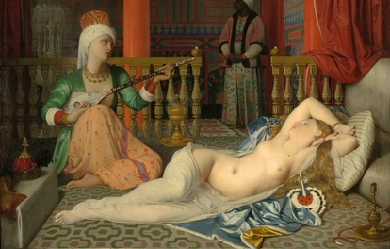
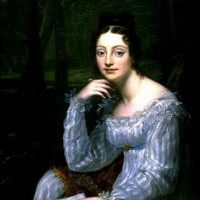
Amable Tastu, nom de plume de Sabine Casimire Amable Voïart, née le 31 août 1798 à Metz et morte le 10 janvier 1885 à Palaiseau, est une femme de lettres française. Biographie Sabine Casimire Amable Voïart, née rue des clercs à Metz, est la fille de l’administrateur aux vivres de l’armée Jacques-Philippe Voïart et de Jeanne-Amable Bouchotte, sœur du ministre de la guerre, Jean-Baptiste Bouchotte. Elle perd sa mère en 1802 et en 1806, son père se remarie avec Anne-Élisabeth-Élise Petitpain, femme de lettres de Nancy qui partage avec Amable sa connaissance de l’anglais, de l’allemand et de l’italien. En 1816, elle épouse l’imprimeur perpignanais Joseph Tastu qui la trompe. Un an plus tard, elle met au monde un fils, Eugène. L’année suivante, en 1819, son mari quitte Perpignan et se rend à Paris pour reprendre l’imprimerie libérale des frères Beaudouin, au no 36 rue de Vaugirard. Sous son nom de plume d’Amable Tastu, elle écrit et publie des poèmes qui lui apportent la notoriété. C’est la muse romantique par excellence. En 1851, la rose Amable Tastu est créée en hommage. Après des années de prospérité, les affaires de son mari déclinent. La crise économique de 1830 a raison de son imprimerie et il fait faillite. Amable abandonne alors la poésie pour se livrer à des productions alimentaires afin de subvenir aux besoins de sa famille. Christine Planté précise: « Elle dut vivre de sa plume en rédigeant des travaux alimentaires pour combler l’indigence de son mari ruiné par la révolution de Juillet et inapte à se refaire ». Elle collabore régulièrement au Mercure de France et à La Muse française. Elle publie des ouvrages pédagogiques, des traductions, des sommes historiques, un Cours d’histoire de France, publié en accord avec le ministre de l’Instruction publique, un volume sur la littérature allemande, un autre sur la littérature italienne. Elle est également l’auteure de libretti pour des musiciens comme Saint-Saëns. En 1849, après la mort de son mari, elle suit son fils Eugène dans ses missions diplomatiques à Chypre et à Bagdad. En 1866, elle revient pour quelques années à Paris. En 1871, elle s’installe à Palaiseau où elle continue à mener une intense vie sociale et y meurt le 10 janvier 1885. Relations Elle est très appréciée de Lamartine, Sainte Beuve, Hugo, Chateaubriand, Marceline Desbordes-Valmore. Victor Hugo lui dédie son Moïse sur le Nil et Chateaubriand son Camoens. Sainte-Beuve compose en son honneur une élégie de 18 quatrains et lui consacre 16 pages dans ses Portraits contemporains.
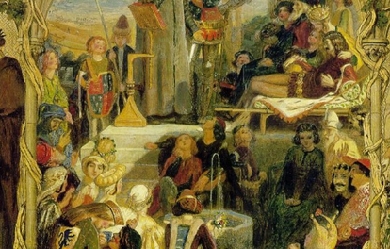
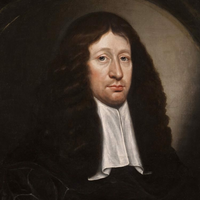
Andrew Marvell (31 March 1621– 16 August 1678) was an English metaphysical poet, satirist and politician who sat in the House of Commons at various times between 1659 and 1678. During the Commonwealth period he was a colleague and friend of John Milton. His poems range from the love-song “To His Coy Mistress”, to evocations of an aristocratic country house and garden in “Upon Appleton House” and “The Garden”, the political address “An Horatian Ode upon Cromwell’s Return from Ireland”, and the later personal and political satires “Flecknoe” and “The Character of Holland”. Early life Marvell was born in Winestead-in-Holderness, East Riding of Yorkshire, near the city of Kingston upon Hull, the son of a Church of England clergyman also named Andrew Marvell. The family moved to Hull when his father was appointed Lecturer at Holy Trinity Church there, and Marvell was educated at Hull Grammar School. A secondary school in the city, the Andrew Marvell Business and Enterprise College, is now named after him. At the age of 13, Marvell attended Trinity College, Cambridge and eventually received a BA degree. A portrait of Marvell attributed to Godfrey Kneller hangs in Trinity College’s collection. Afterwards, from the middle of 1642 onwards, Marvell probably travelled in continental Europe. He may well have served as a tutor for an aristocrat on the Grand Tour, but the facts are not clear on this point. While England was embroiled in the civil war, Marvell seems to have remained on the continent until 1647. It is not known exactly where his travels took him, except that he was in Rome in 1645 and Milton later reported that Marvell had mastered four languages, including French, Italian and Spanish. First poems and Marvell’s time at Nun Appleton Marvell’s first poems, which were written in Latin and Greek and published when he was still at Cambridge, lamented a visitation of the plague and celebrated the birth of a child to King Charles I and Queen Henrietta Maria. He only belatedly became sympathetic to the successive regimes during the Interregnum after Charles I’s execution on 30 January 1649. His “Horatian Ode”, a political poem dated to early 1650, responds with lament to the regicide even as it praises Oliver Cromwell’s return from Ireland. Circa 1650–52, Marvell served as tutor to the daughter of the Lord General Thomas Fairfax, who had recently relinquished command of the Parliamentary army to Cromwell. He lived during that time at Nun Appleton Hall, near York, where he continued to write poetry. One poem, “Upon Appleton House, To My Lord Fairfax”, uses a description of the estate as a way of exploring Fairfax’s and Marvell’s own situation in a time of war and political change. Probably the best-known poem he wrote at this time is “To His Coy Mistress”. Anglo-Dutch War and employment as Latin secretary During the period of increasing tensions leading up to the First Anglo-Dutch War of 1653, Marvell wrote the satirical “Character of Holland,” repeating the then current stereotype of the Dutch as “drunken and profane”: "This indigested vomit of the Sea,/ Fell to the Dutch by Just Propriety.” He became a tutor to Cromwell’s ward, William Dutton, in 1653, and moved to live with his pupil at the house of John Oxenbridge in Eton. Oxenbridge had made two trips to Bermuda, and it is thought that this inspired Marvell to write his poem Bermudas. He also wrote several poems in praise of Cromwell, who was by this time Lord Protector of England. In 1656 Marvell and Dutton travelled to France, to visit the Protestant Academy of Saumur. In 1657, Marvell joined Milton, who by that time had lost his sight, in service as Latin secretary to Cromwell’s Council of State at a salary of £200 a year, which represented financial security at that time. Oliver Cromwell died in 1658. He was succeeded as Lord Protector by his son Richard. In 1659 Marvell was elected Member of Parliament for Kingston-upon-Hull in the Third Protectorate Parliament. He was paid a rate of 6 shillings, 8 pence per day during sittings of parliament, a financial support derived from the contributions of his constituency. He was re-elected MP for Hull in 1660 for the Convention Parliament. After the Restoration The monarchy was restored to Charles II in 1660. Marvell avoided punishment for his own co-operation with republicanism, and he helped convince the government of Charles II not to execute John Milton for his antimonarchical writings and revolutionary activities. The closeness of the relationship between the two former colleagues is indicated by the fact that Marvell contributed an eloquent prefatory poem, entitled “On Mr. Milton’s Paradise Lost”, to the second edition of Milton’s epic Paradise Lost. According to a biographer: “Skilled in the arts of self-preservation, he was not a toady.” In 1661 Marvell was re-elected MP for Hull in the Cavalier Parliament. He eventually came to write several long and bitterly satirical verses against the corruption of the court. Although circulated in manuscript form, some finding anonymous publication in print, they were too politically sensitive and thus dangerous to be published under his name until well after his death. Marvell took up opposition to the 'court party’, and satirised them anonymously. In his longest verse satire, Last Instructions to a Painter, written in 1667, Marvell responded to the political corruption that had contributed to English failures during the Second Anglo-Dutch War. The poem did not find print publication until after the Revolution of 1688–9. The poem instructs an imaginary painter how to picture the state without a proper navy to defend them, led by men without intelligence or courage, a corrupt and dissolute court, and dishonest officials. Of another such satire, Samuel Pepys, himself a government official, commented in his diary, “Here I met with a fourth Advice to a Painter upon the coming in of the Dutch and the End of the War, that made my heart ake to read, it being too sharp and so true.” From 1659 until his death in 1678, Marvell was serving as London agent for the Hull Trinity House, a shipmasters’ guild. He went on two missions to the continent, one to the Dutch Republic and the other encompassing Russia, Sweden, and Denmark. He spent some time living in a cottage on Highgate Hill in north London, where his time in the area is recorded by a bronze plaque that bears the following inscription: Four feet below this spot is the stone step, formerly the entrance to the cottage in which lived Andrew Marvell, poet, wit, and satirist; colleague with John Milton in the foreign or Latin secretaryship during the Commonwealth; and for about twenty years M.P. for Hull. Born at Winestead, Yorkshire, 31st March, 1621, died in London, 18th August, 1678, and buried in the church of St. Giles-in-the-Fields. This memorial is placed here by the London County Council, December, 1898. A floral sundial in the nearby Lauderdale House bears an inscription quoting lines from of his poem “The Garden”. He died suddenly in 1678, while in attendance at a popular meeting of his old constituents at Hull. His health had previously been remarkably good; and it was supposed by many that he was poisoned by some of his political or clerical enemies. Marvell was buried in the church of St Giles in the Fields in central London. His monument, erected by his grateful constituency, bears the following inscription: Near this place lyeth the body of Andrew Marvell, Esq., a man so endowed by Nature, so improved by Education, Study, and Travel, so consummated by Experience, that, joining the peculiar graces of Wit and Learning, with a singular penetration and strength of judgment; and exercising all these in the whole course of his life, with an unutterable steadiness in the ways of Virtue, he became the ornament and example of his age, beloved by good men, feared by bad, admired by all, though imitated by few; and scarce paralleled by any. But a Tombstone can neither contain his character, nor is Marble necessary to transmit it to posterity; it is engraved in the minds of this generation, and will be always legible in his inimitable writings, nevertheless. He having served twenty years successfully in Parliament, and that with such Wisdom, Dexterity, and Courage, as becomes a true Patriot, the town of Kingston-upon-Hull, from whence he was deputed to that Assembly, lamenting in his death the public loss, have erected this Monument of their Grief and their Gratitude, 1688. It may be noted that his epitaph pays more tribute to his political career than his poetry. Prose works Marvell also wrote anonymous prose satires criticizing the monarchy and Catholicism, defending Puritan dissenters, and denouncing censorship. The Rehearsal Transpros’d, an attack on Samuel Parker, was published in two parts in 1672 and 1673. In 1676, Mr. Smirke; or The Divine in Mode, a work critical of intolerance within the Church of England, was published together with a “Short Historical Essay, concerning General Councils, Creeds, and Impositions, in matters of Religion.” Marvell’s pamphlet An Account of the Growth of Popery and Arbitrary Government in England, published in late 1677, alleged that: “There has now for diverse Years, a design been carried on, to change the Lawfull Government of England into an Absolute Tyranny, and to convert the established Protestant Religion into down-right Popery”. John Kenyon described it as “one of the most influential pamphlets of the decade” and G. M. Trevelyan called it: “A fine pamphlet, which throws light on causes provocative of the formation of the Whig party”. A 1678 work published anonymously ("by a Protestant") in defense of John Howe against the attack of his fellow-dissenter, the severe Calvinist Thomas Danson, is also probably by Marvell. Its full title is Remarks upon a late disingenuous discourse, writ by one T.D. under the pretence de causa Dei, and of answering Mr. John Howe’s letter and postscript of God’s prescience, &c., affirming, as the Protestant docrine, that GOd doth by efficacious influence universally move and determine men to all their actions, even to those that are most wicked. Views Although Marvell became a Parliamentarian, he was not a Puritan. He had flirted briefly with Catholicism as a youth, and was described in his thirties (on the Saumur visit) as “a notable English Italo-Machiavellian”. During his lifetime, his prose satires were much better known than his verse. Vincent Palmieri noted that Marvell is sometimes known as the “British Aristides” for his incorruptible integrity in life and poverty at death. Many of his poems were not published until 1681, three years after his death, from a collection owned by Mary Palmer, his housekeeper. After Marvell’s death she laid dubious claim to having been his wife, from the time of a secret marriage in 1667. Marvell’s poetic style T. S. Eliot wrote of Marvell’s style that 'It is more than a technical accomplishment, or the vocabulary and syntax of an epoch; it is, what we have designated tentatively as wit, a tough reasonableness beneath the slight lyric grace’. He also identified Marvell and the metaphysical school with the 'dissociation of sensibility’ that occurred in 17th-century English literature; Eliot described this trend as 'something which... happened to the mind of England... it is the difference between the intellectual poet and the reflective poet’. Poets increasingly developed a self-conscious relationship to tradition, which took the form of a new emphasis on craftsmanship of expression and an idiosyncratic freedom in allusions to Classical and Biblical sources. Marvell’s most celebrated lyric, “To His Coy Mistress”, combines an old poetic conceit (the persuasion of the speaker’s lover by means of a carpe diem philosophy) with Marvell’s typically vibrant imagery and easy command of rhyming couplets. Other works incorporate topical satire and religious themes. References Wikipedia—https://en.wikipedia.org/wiki/Andrew_Marvell
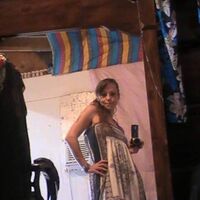
About Me: Please leave a comment on my poetry and stories thank you Blessed Be 37, Mother of 2 gorgeous daughters 13 n 10, Found my high school sweetheart after 15 years and now we celebrated our 1yr anniversary aug-27-13. Ill never let him go no matter what. I Love writing poetry and short stories. Its my way to relieve my over stuffed mind that is always stuck on play. I write because that is the only way I know how to express myself. I'm horrible talking face to face because of my Social Anxiety. I hate it but i have friends and family who love me and help me thru it. My Hobbies: Horseback riding,biking,roller skating, coloring,taking walks,writing poetry and more My Achievements: People in our life are not strangers just friends we haven't met yet :-) Please add me toYOUR favorites and a friend.. as i will be happy to do the same :-) Blessed Be Published In Pocono Record: Eastern Pocono Community News *Your Page: *So High And Free -January-26-2001 *The Day YouBEGIN To Live..June-8-2001 Awards:-------------------------------------------------------- *Poetry.com: & the International Library of Poetry: Awarded Prestigious Editor's Choice Award, >Outstanding Achievement in Poetry: *VIP# P6125073- Rain- 2004 *VIP# P612507- You're- June 2005 *VIP#P1854496- The Day You Begin To Live -December 2000 Awaking To Sunshine (book- Natures of Echoes) *Award of MeritCERTIFICATE : from John Campbell: Editor & Publisher, Eddie-Lou Cole : Poetry Editor, Rank Honorable Mention In Appreciation December-15-1991 World of Poetry: *Winter Is
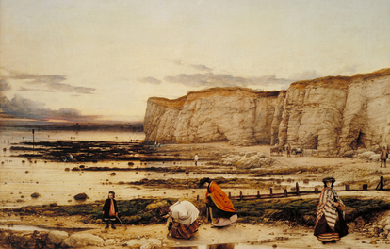
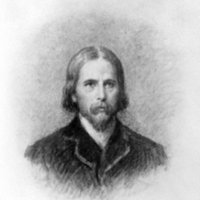
Sydney Thompson Dobell (5 April 1824– 22 August 1874) was an English poet and critic, and a member of the so-called Spasmodic school. He was born at Cranbrook, Kent. His father, John Dobell, was a wine merchant, his mother a daughter of Samuel Thompson (1766–1837), a London political reformer. The family moved to Cheltenham when Dobell was twelve years old. He was educated privately, and never attended either school or university. He refers to this in some lines on Cheltenham College in imitation of Chaucer, written in his eighteenth year. After a five-year engagement he married, in 1844, Emily Fordham, a lady of good family. Acquaintance with James Stansfeld (subsequently Sir James Stansfeld) and with the Birmingham preacher-politician George Dawson fed the young enthusiast’s ardour for the liberalism of the day, and later led to the foundation of the Society of the Friends of Italy.
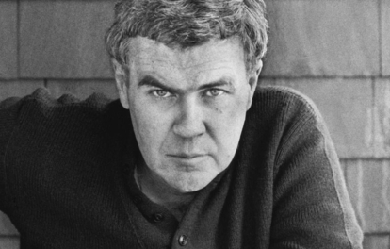
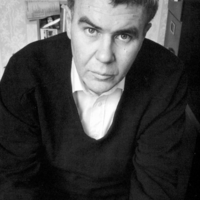
Raymond Clevie Carver, Jr. (May 25, 1938– August 2, 1988) was an American short-story writer and poet. Carver contributed to the revitalization of the American short story in literature during the 1980s. Early life Carver was born in Clatskanie, Oregon, a mill town on the Columbia River, and grew up in Yakima, Washington, the son of Ella Beatrice (née Casey) and Clevie Raymond Carver. His father, a sawmill worker from Arkansas, was a fisherman and heavy drinker. Carver’s mother worked on and off as a waitress and a retail clerk. His one brother, James Franklin Carver, was born in 1943. Carver was educated at local schools in Yakima, Washington. In his spare time, he read mostly novels by Mickey Spillane or publications such as Sports Afield and Outdoor Life, and hunted and fished with friends and family. After graduating from Yakima High School in 1956, Carver worked with his father at a sawmill in California. In June 1957, at age 19, he married 16-year-old Maryann Burk, who had just graduated from a private Episcopal school for girls. Their daughter, Christine La Rae, was born in December 1957. Their second child, a boy named Vance Lindsay, was born a year later. He supported his family by working as a delivery man, janitor, library assistant, and sawmill laborer. During their marriage, Maryann also supported the family by working as an administrative assistant and a high school English teacher, salesperson, and waitress. Writing career Carver became interested in writing in Paradise, California, where he had moved with his family to be close to his mother-in-law. While attending Chico State College, he enrolled in a creative writing course taught by the novelist John Gardner, a recent doctoral graduate of the Iowa Writers’ Workshop who became a mentor and had a major influence on Carver’s life and career. Carver’s first published story, “The Furious Seasons”, appeared in 1961. More florid than his later work, the story strongly bore the influence of William Faulkner. “Furious Seasons” was later used as a title for a collection of stories published by Capra Press, and is now in the recent collection, No Heroics, Please and Call If You Need Me. It is a common misconception that Carver was influenced by Ernest Hemingway, as both writers exhibit a similar economical and plain prose style. In his essay “On Influence”, however, Carver states clearly that, while he was an admirer of Hemingway’s fiction, he never saw him as an influence, citing instead the work of Lawrence Durrell. Carver continued his studies under the short-story writer Richard Cortez Day (like Gardner, a recent PhD alumnus of the Iowa program) at Humboldt State College in Arcata, California. After electing not to take the foreign language courses required by the English program, he received his B.A. in general studies in 1963. During this period he was first published and served as editor for Toyon, the university’s literary magazine, in which he published several of his own pieces under his own name as well as the pseudonym John Vale. With his B– average—exacerbated by his penchant to forsake coursework for literary endeavors—ballasted by a sterling recommendation from Day, Carver was accepted into the Iowa Writers’ Workshop on a $1,000 fellowship for the 1963–1964 academic year. Homesick for California and unable to fully acclimate to the program’s upper middle class milieu, he only completed 12 credits out of the 30 required for a M.A. degree or 60 for the M.F.A. degree. Although he was awarded a fellowship for a second year of study from program director Paul Engle after Maryann Carver personally interceded and compared her husband’s plight to Tennessee Williams’ deleterious experience in the program three decades earlier, Carver decided to leave the program at the end of the semester. Maryann (who postponed completing her education to support her husband’s educational and literary endeavors) eventually graduated from San Jose State College in 1970 and taught English at Los Altos High School until 1977, when she enrolled in the University of California, Santa Barbara’s doctoral program in English. In the mid-1960s, Carver and his family resided in Sacramento, California, where he briefly worked at a bookstore before taking a position as a night custodian at Mercy Hospital. He did all of the janitorial work in the first hour and then wrote at the hospital through the rest of the night. He audited classes at what was then Sacramento State College, including workshops with poet Dennis Schmitz. Carver and Schmitz soon became friends, and Carver wrote and published his first book of poems, Near Klamath, under Schmitz’s guidance. With the appearance of Will You Please Be Quiet, Please? in Martha Foley’s annual Best American Short Stories anthology and the impending publication of Near Klamath by the English Club of Sacramento State College, 1967 was a landmark year for Carver. He briefly enrolled in the library science graduate program at the University of Iowa that summer but returned to California following the death of his father. Shortly thereafter, the Carvers relocated to Palo Alto, California, so he could take his first white-collar job at Science Research Associates (a subsidiary of IBM), where he worked intermittently as a textbook editor and public relations director through 1970. Following a 1968 sojourn to Israel, the Carvers relocated to San Jose, California; as Maryann finished her undergraduate degree, he continued his graduate studies in library science at San Jose State through the end of 1969 before failing once again to take a degree. Nevertheless, he established vital literary connections with Gordon Lish and the poet/publisher George Hitchcock during this period. After the publication of “Neighbors” in the June 1971 issue of Esquire at the instigation of Lish (by now ensconced as the magazine’s fiction editor), Carver began to teach at the University of California, Santa Cruz at the behest of provost James B. Hall (an Iowa alumnus and early mentor to Ken Kesey at the University of Oregon), commuting from his new home in Sunnyvale, California. Following a succession of failed applications, he received a $4,000 Stegner Fellowship to study in the prestigious non-degree graduate creative writing program at Stanford University during the 1972–1973 term, where he cultivated friendships with Kesey-era luminaries Ed McClanahan and Gurney Norman in addition to contemporaneous fellows Chuck Kinder, Max Crawford, and William Kittredge. The fellowship enabled the Carvers to buy a house in Cupertino, California. He took on another teaching job at the University of California, Berkeley that year and briefly rented a pied-à-terre in the city; this development was largely precipitated by his instigation of an extramarital affair with Diane Cecily, a University of Montana administrator and mutual friend of Kittredge who would subsequently marry Kinder. During his years of working at miscellaneous jobs, rearing children, and trying to write, Carver started abusing alcohol. By his own admission, he essentially gave up writing and took to full-time drinking. In the fall semester of 1973, Carver was a visiting lecturer in the Iowa Writers’ Workshop with John Cheever, but Carver stated that they did less teaching than drinking and almost no writing. With the assistance of Kinder and Kittredge, he attempted to simultaneously commute to California and maintain his lectureship at Santa Cruz; after missing all but a handful of classes due to the inherent logistical hurdles of this arrangement (including various alcohol-related illnesses), Hall gently enjoined Carver to resign his position. The next year, after leaving Iowa City, Carver went to a treatment center to attempt to overcome his alcoholism, but continued drinking for three years. His first short story collection, Will You Please Be Quiet, Please?, was published in 1976. The collection itself was shortlisted for the National Book Award, though it sold fewer than 5,000 copies that year. After being hospitalized three times (between June 1976 and February or March 1977), Carver began his “second life” and stopped drinking on June 2, 1977, with the help of Alcoholics Anonymous. While he continued to regularly smoke marijuana and later experimented with cocaine at the behest of Jay McInerney during a 1980 visit to New York City, Carver believed he would have died of alcoholism at the age of 40 had he not overcome his drinking. Carver was nominated again in 1984 for his third major-press collection, Cathedral, the volume generally perceived as his best. Included in the collection are the award-winning stories “A Small, Good Thing”, and “Where I’m Calling From”. John Updike selected the latter for inclusion in The Best American Short Stories of the Century. For his part, Carver saw Cathedral as a watershed in his career, in its shift towards a more optimistic and confidently poetic style. Personal life and death Decline of first marriage The following excerpt from Scott Driscoll’s review of Maryann Burk Carver’s 2006 memoir describes the decline of Maryann and Raymond’s marriage. The fall began with Ray’s trip to Missoula, Mont., in '72 to fish with friend and literary helpmate Bill Kittredge. That summer Ray fell in love with Diane Cecily, an editor at the University of Montana, whom he met at Kittredge’s birthday party. “That’s when the serious drinking began. It broke my heart and hurt the children. It changed everything.” “By fall of '74", writes Carver, “he was more dead than alive. I had to drop out of the Ph.D. program so I could get him cleaned up and drive him to his classes”. Over the next several years, Maryann’s husband physically abused her. Friends urged her to leave Raymond. “But I couldn’t. I really wanted to hang in there for the long haul. I thought I could outlast the drinking. I’d do anything it took. I loved Ray, first, last and always.” Carver describes, without a trace of rancor, what finally put her over the edge. In the fall of '78, with a new teaching position at the University of Texas at El Paso, Ray started seeing Tess Gallagher, a writer from Port Angeles, who would become his muse and wife near the end of his life. “It was like a contretemps. He tried to call me to talk about where we were. I missed the calls. He knew he was about to invite Tess to Thanksgiving.” So he wrote a letter instead. “I thought, I’ve gone through all those years fighting to keep it all balanced. Here it was, coming at me again, the same thing. I had to get on with my own life. But I never fell out of love with him.” Second marriage Carver met the poet Tess Gallagher at a writers’ conference in Dallas, Texas, in November 1977. Beginning in January, 1979, Carver and Gallagher lived together in El Paso, Texas; in a borrowed cabin near Port Angeles, Washington; and in Tucson, Arizona. In 1980, the two moved to Syracuse, New York, where Gallagher had been appointed the coordinator of the creative writing program at Syracuse University; Carver taught as a professor in the English department. He and Gallagher jointly purchased a house in Syracuse, at 832 Maryland Avenue. In ensuing years, the house became so popular that the couple had to hang a sign outside that read “Writers At Work” in order to be left alone. In 1982, Carver and first wife, Maryann, were divorced. He married Gallagher in 1988 in Reno, Nevada. Six weeks later, on August 2, 1988, Carver died in Port Angeles, Washington, from lung cancer at the age of 50. In the same year, he was inducted into the American Academy of Arts and Letters. In December 2006, Gallagher published an essay in The Sun magazine, titled “Instead of Dying”, about alcoholism and Carver’s having maintained his sobriety. The essay is an adaptation of a talk she initially delivered at the Welsh Academy’s Academi Intoxication Conference in 2006. The first lines read: “Instead of dying from alcohol, Raymond Carver chose to live. I would meet him five months after this choice, so I never knew the Ray who drank, except by report and through the characters and actions of his stories and poems.” Death On August 2, 1988, Carver died from lung cancer at the age of 50. He is buried at Ocean View Cemetery in Port Angeles, Washington. The inscription on his tombstone reads: LATE FRAGMENT And did you get what you wanted from this life, even so? I did. And what did you want? To call myself beloved, to feel myself beloved on the earth. His poem “Gravy” is also inscribed. As Carver’s will directed, Tess Gallagher assumed the management of his literary estate. Memorials In Carver’s birth town of Clatskanie, Oregon, a memorial park and statue were constructed in the late 2000s spearheaded by the local Friends of the Library, using mostly local donations. Tess Gallagher was present at the dedication. It is located in the old town on the corner of Lillich and Nehalem Streets, across from the library. A block away, the building where Raymond Carver was born still stands. There is a plaque of Carver in the foyer. Legacy and posthumous publications The novelist Chuck Kinder published Honeymooners: A Cautionary Tale (2001), a roman à clef about his friendship with Carver in the 1970s. Carver’s high school sweetheart and first wife, Maryann Burk Carver, wrote a memoir of her years with Carver, What it Used to be Like: A Portrait of My Marriage to Raymond Carver (2006). The New York Times Book Review and San Francisco Chronicle named Carol Sklenicka’s unauthorized biography, Raymond Carver: A Writer’s Life (2009), published by Scribner, one of the Best Ten Books of that year; and the San Francisco Chronicle deemed it: “exhaustively researched and definitive biography”. Carver’s widow, Tess Gallagher, refused to engage with Sklenica. His final (incomplete) collection of seven stories, titled Elephant in Britain (included in “Where I’m Calling From”) was composed in the five years before his death. The nature of these stories, especially “Errand”, have led to some speculation that Carver was preparing to write a novel. Only one piece of this work has survived– the fragment “The Augustine Notebooks”, first printed in No Heroics, Please. Tess Gallagher published five Carver stories posthumously in Call If You Need Me; one of the stories ("Kindling") won an O. Henry Award in 1999. In his lifetime Carver won five O. Henry Awards; these winning stories were “Are These Actual Miles” (originally titled “What is it?”) (1972), “Put Yourself in My Shoes” (1974), “Are You A Doctor?” (1975), “A Small, Good Thing” (1983), and “Errand” (1988). Tess Gallagher fought with Knopf for permission to republish the stories in What We Talk About When We Talk About Love as they were originally written by Carver, as opposed to the heavily edited and altered versions that appeared in 1981 under the editorship of Gordon Lish. The book, entitled Beginners, was released in hardback on October 1, 2009 in Great Britain, followed by its U.S. publication in the Library of America edition that collected all of Carver’s short fiction in a single volume. Literary characteristics Carver’s career was dedicated to short stories and poetry. He described himself as “inclined toward brevity and intensity” and “hooked on writing short stories” (in the foreword of Where I’m Calling From, a collection published in 1988 and a recipient of an honorable mention in the 2006 New York Times article citing the best works of fiction of the previous 25 years). Another stated reason for his brevity was "that the story [or poem] can be written and read in one sitting." This was not simply a preference but, particularly at the beginning of his career, a practical consideration as he juggled writing with work. His subject matter was often focused on blue-collar experience, and was clearly reflective of his own life. Characteristics of minimalism are generally seen as one of the hallmarks of Carver’s work, although, as reviewer David Wiegand notes: Carver never thought of himself as a minimalist or in any category, for that matter. “He rejected categories generally,” Sklenicka says. “I don’t think he had an abstract mind at all. He just wasn’t built that way, which is why he’s so good at picking the right details that will stand for many things.” Carver’s editor at Esquire, Gordon Lish, was instrumental in shaping Carver’s prose in this direction– where his earlier tutor John Gardner had advised Carver to use fifteen words instead of twenty-five, Lish instructed Carver to use five in place of fifteen. Objecting to the “surgical amputation and transplantation” of Lish’s heavy editing, Carver eventually broke with him. During this time, Carver also submitted poetry to James Dickey, then poetry editor of Esquire. Carver’s style has also been described as dirty realism, which connected him with a group of writers in the 1970s and 1980s that included Richard Ford and Tobias Wolff (two writers with whom Carver was closely acquainted), as well as others such as Ann Beattie, Frederick Barthelme, and Jayne Anne Phillips. With the exception of Beattie, who wrote about upper-middle-class people, these were writers who focused on sadness and loss in the everyday lives of ordinary people—often lower-middle class or isolated and marginalized people. Works Fiction Collections * Will You Please Be Quiet, Please? (first published 1976) * Furious Seasons and other stories (1977) * What We Talk About When We Talk About Love (1981) * Cathedral (1983) * Elephant (1988)– this title only published in Great Britain; included as a section of Where I’m Calling From: New & Selected Stories in the U.S. Compilations * Where I’m Calling From: New & Selected Stories (1988) * Short Cuts: Selected Stories (1993)– published to accompany the Robert Altman film Short Cuts * Collected Stories (2009)– complete short fiction including Beginners Poetry Collections * Near Klamath (1968) * Winter Insomnia (1970) * At Night The Salmon Move (1976) * Fires (1983) * Where Water Comes Together With Other Water (1985) * Ultramarine (1986) * A New Path To The Waterfall (1989) * Gravy (Unknown year) Compilations * In a Marine Light: Selected Poems (1988) * All of Us: The Collected Poems (1996) Screenplays * Dostoevsky (1985, with Tess Gallagher) Films and theatre adaptations * Short Cuts directed by Robert Altman (1993), based on nine Carver short stories and a poem * Everything Goes directed by Andrew Kotatko (2004), starring Hugo Weaving and Abbie Cornish, based on Carver’s short story “Why Don’t You Dance?” * Whoever Was Using This Bed, also directed by Andrew Kotatko (2016), starring Jean-Marc Barr, Radha Mitchell and Jane Birkin, based on Carver’s short story of the same name * Jindabyne directed by Ray Lawrence (2006), based on Carver’s short story “So Much Water So Close to Home” * “After The Denim” directed by Gregory D. Goyins (2010) starring Tom Bower and Karen Landry, based on Carver’s short story “If It Please You” * Everything Must Go directed by Dan Rush (2010), and starring Will Ferrell, based on Carver’s short story “Why Don’t You Dance?” * Carver a production directed by William Gaskill at London’s Arcola Theatre in 1995, adapted from five Carver short stories including “What’s In Alaska?” “Put Yourself in My Shoes” and “Intimacy” * Studentova žena (Croatian) directed by Goran Kovač, based on “The Student’s Wife” * Carousel (Croatian) directed by Toma Zidić, inspired by “Ashtray” * Men Who Don’t Work directed by Alexander Atkins and Andrew Franks, based on “What Do You Do in San Francisco?” * Birdman or (The Unexpected Virtue of Ignorance), directed by Alejandro G. Iñárritu, depicts the mounting of a Broadway production of “What We Talk About When We Talk About Love” as its central storyline. The film’s main character, Riggan Thomson, attributes his choice of acting as a profession to a complimentary note he once received from Raymond Carver written on a cocktail napkin. The film also preludes with Carver’s poem “Late Fragment.” In February 2015, Birdman won four Oscars, including the Academy Award for Best Picture. Musical adaptions * Everything’s Turning to White is a folk rock track written and performed by Paul Kelly on the album So Much Water So Close to Home (1989), which was based on Carver’s short story of the same name. References Wikipedia—https://en.wikipedia.org/wiki/Raymond_Carver
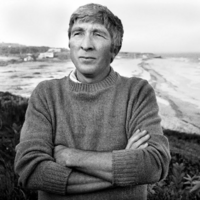
John Updike was a poet, essayist, short-story writer, critic, and novelist John Updike was born in Shillington, Pennsylvania, on March 18, 1932. His father taught high school math, and his mother wrote short stories and novels. Updike received his BA from Harvard University in 1954, the year he began to publish in The New Yorker. Thomas M. Disch wrote in Poetry magazine, "Updike enjoys such pre-eminence as a novelist that his poetry could be mistaken as a hobby or a foible," adding, "It is a poetry of civility—in its epigrammatical lucidity . . . and in its tone of vulgar bonhomie and good appetite." The Los Angeles Times noted that he "has earned an . . . imposing stance on the literary landscape . . . earning virtually every American literary award, repeated bestsellerdom and the near-royal status of the American author-celebrity." Updike is the author of more than fifty books. Among his volumes of poetry are Americana and Other Poems (Alfred A. Knopf, 2001), Collected Poems 1953-1993 (1993), Facing Nature (1985), Tossing and Turning (1977), Seventy Poems (1972), Midpoint and Other Poems (1969), and The Carpentered Hen and Other Tame Creatures (1958). His novels and short-story collections include Toward the End of Time (1997), The Afterlife and Other Stories (1994), Problems and Other Stories (1981), Marry Me (1976), Rabbit Redux (1971), and Couples (1968). Updike received numerous honors and awards including the National Book Award, American Book Award, National Book Critics Circle Award, and a National Arts Club Medal of Honor. He was awarded a Pulitzer Prize in 1982 for Rabbit is Rich and another Pulitzer Prize in 1990 for Rabbit at Rest. John Updike died due to complications of lung cancer on January 27, 2009. Poetry The Carpentered Hen and Other Tame Creatures (Harper and Brothers, 1958) Telephone Poles and Other Poems (Alfred A. Knopf, 1963) Midpoint and Other Poems (1969) Tossing and Turning (1977) Facing Nature (1985) Collected Poems 1953-1993 (1993) Americana: and Other Poems (2001) References Poets.org - www.poets.org/poet.php/prmPID/660
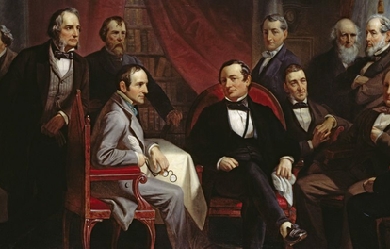
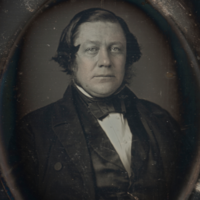
Washington Irving (April 3, 1783– November 28, 1859) was an American short story writer, essayist, biographer, historian, and diplomat of the early 19th century. He is best known for his short stories “Rip Van Winkle” (1819) and “The Legend of Sleepy Hollow” (1820), both of which appear in his book The Sketch Book of Geoffrey Crayon, Gent. His historical works include biographies of George Washington, Oliver Goldsmith, and Muhammad, and several histories of 15th-century Spain dealing with subjects such as Christopher Columbus, the Moors and the Alhambra. Irving served as the U.S. ambassador to Spain from 1842 to 1846. He made his literary debut in 1802 with a series of observational letters to the Morning Chronicle, written under the pseudonym Jonathan Oldstyle. After moving to England for the family business in 1815, he achieved international fame with the publication of The Sketch Book of Geoffrey Crayon, Gent. in 1819–20. He continued to publish regularly—and almost always successfully—throughout his life, and just eight months before his death (at age 76, in Tarrytown, New York), completed a five-volume biography of George Washington. Irving, along with James Fenimore Cooper, was among the first American writers to earn acclaim in Europe, and Irving encouraged American authors such as Nathaniel Hawthorne, Herman Melville, Henry Wadsworth Longfellow, and Edgar Allan Poe. Irving was also admired by some European writers, including Walter Scott, Lord Byron, Thomas Campbell, Francis Jeffrey, and Charles Dickens. As America’s first genuine internationally best-selling author, Irving advocated for writing as a legitimate profession and argued for stronger laws to protect American writers from copyright infringement. Biography Early years Washington Irving’s parents were William Irving, Sr., originally of Quholm, Shapinsay, Orkney, and Sarah (née Sanders), Scottish-English immigrants. They married in 1761 while William was serving as a petty officer in the British Navy. They had eleven children, eight of whom survived to adulthood. Their first two sons, each named William, died in infancy, as did their fourth child, John. Their surviving children were: William, Jr. (1766), Ann (1770), Peter (1771), Catherine (1774), Ebenezer (1776), John Treat (1778), Sarah (1780), and Washington. The Irving family settled in Manhattan, New York City, and was part of the city’s small, vibrant merchant class when Washington Irving was born on April 3, 1783, the same week city residents learned of the British ceasefire that ended the American Revolution; Irving’s mother named him after the hero of the revolution, George Washington. At age six, with the help of a nanny, Irving met his namesake, who was then living in New York after his inauguration as president in 1789. The president blessed young Irving, an encounter Irving later commemorated in a small watercolor painting, which still hangs in his home today. The Irvings lived at 131 William Street at the time of Washington Irving’s birth. The family later moved across the street to 128 William St. Several of Washington Irving’s older brothers became active New York merchants, and they encouraged their younger brother’s literary aspirations, often supporting him financially as he pursued his writing career. An uninterested student, Irving preferred adventure stories and drama and, by age fourteen, was regularly sneaking out of class in the evenings to attend the theater. The 1798 outbreak of yellow fever in Manhattan prompted his family to send him to healthier climes upriver, and Irving was dispatched to stay with his friend James Kirke Paulding in Tarrytown, New York. It was in Tarrytown that Irving became familiar with the nearby town of Sleepy Hollow, with its quaint Dutch customs and local ghost stories. Irving made several other trips up the Hudson as a teenager, including an extended visit to Johnstown, New York, where he passed through the Catskill mountain region, the setting for “Rip Van Winkle”. "[O]f all the scenery of the Hudson", Irving wrote later, “the Kaatskill Mountains had the most witching effect on my boyish imagination”. The 19-year-old Irving began writing letters to the New York Morning Chronicle in 1802, submitting commentaries on the city’s social and theater scene under the name of Jonathan Oldstyle. The name, which purposely evoked the writer’s Federalist leanings, was the first of many pseudonyms Irving would employ throughout his career. The letters brought Irving some early fame and moderate notoriety. Aaron Burr, a co-publisher of the Chronicle, was impressed enough to send clippings of the Oldstyle pieces to his daughter, Theodosia, while writer Charles Brockden Brown made a trip to New York to recruit Oldstyle for a literary magazine he was editing in Philadelphia. Concerned for his health, Irving’s brothers financed an extended tour of Europe from 1804 to 1806. Irving bypassed most of the sites and locations considered essential for the development of an upwardly mobile young man, to the dismay of his brother William. William wrote that, though he was pleased his brother’s health was improving, he did not like the choice to “gallop through Italy... leaving Florence on your left and Venice on your right”. Instead, Irving honed the social and conversational skills that would later make him one of the world’s most in-demand guests. “I endeavor to take things as they come with cheerfulness”, Irving wrote, “and when I cannot get a dinner to suit my taste, I endeavor to get a taste to suit my dinner”. While visiting Rome in 1805, Irving struck up a friendship with the American painter Washington Allston, and nearly allowed himself to be persuaded into following Allston into a career as a painter. “My lot in life, however”, Irving said later, “was differently cast”. First major writings Irving returned from Europe to study law with his legal mentor, Judge Josiah Ogden Hoffman, in New York City. By his own admission, he was not a good student, and barely passed the bar in 1806. Irving began actively socializing with a group of literate young men he dubbed “The Lads of Kilkenny”. Collaborating with his brother William and fellow Lad James Kirke Paulding, Irving created the literary magazine Salmagundi in January 1807. Writing under various pseudonyms, such as William Wizard and Launcelot Langstaff, Irving lampooned New York culture and politics in a manner similar to today’s Mad magazine. Salmagundi was a moderate success, spreading Irving’s name and reputation beyond New York. In its seventeenth issue, dated November 11, 1807, Irving affixed the nickname “Gotham”—an Anglo-Saxon word meaning “Goat’s Town”—to New York City. In late 1809, while mourning the death of his seventeen-year-old fiancée Matilda Hoffman, Irving completed work on his first major book, A History of New-York from the Beginning of the World to the End of the Dutch Dynasty, by Diedrich Knickerbocker (1809), a satire on self-important local history and contemporary politics. Prior to its publication, Irving started a hoax akin to today’s viral marketing campaigns; he placed a series of missing person advertisements in New York newspapers seeking information on Diedrich Knickerbocker, a crusty Dutch historian who had allegedly gone missing from his hotel in New York City. As part of the ruse, Irving placed a notice—allegedly from the hotel’s proprietor—informing readers that if Mr. Knickerbocker failed to return to the hotel to pay his bill, he would publish a manuscript Knickerbocker had left behind. Unsuspecting readers followed the story of Knickerbocker and his manuscript with interest, and some New York city officials were concerned enough about the missing historian that they considered offering a reward for his safe return. Riding the wave of public interest he had created with his hoax, Irving—adopting the pseudonym of his Dutch historian—published A History of New York on December 6, 1809, to immediate critical and popular success. “It took with the public”, Irving remarked, “and gave me celebrity, as an original work was something remarkable and uncommon in America”. Today, the surname of Diedrich Knickerbocker, the fictional narrator of this and other Irving works, has become a nickname for Manhattan residents in general. After the success of A History of New York, Irving searched for a job and eventually became an editor of Analectic Magazine, where he wrote biographies of naval heroes like James Lawrence and Oliver Perry. He was also among the first magazine editors to reprint Francis Scott Key’s poem “Defense of Fort McHenry”, which would later be immortalized as “The Star-Spangled Banner”, the national anthem of the United States. Like many merchants and New Yorkers, Irving originally opposed the War of 1812, but the British attack on Washington, D.C. in 1814 convinced him to enlist. He served on the staff of Daniel Tompkins, governor of New York and commander of the New York State Militia. Apart from a reconnaissance mission in the Great Lakes region, he saw no real action. The war was disastrous for many American merchants, including Irving’s family, and in mid-1815, he left for England to attempt to salvage the family trading company. He remained in Europe for the next seventeen years. Irving was elected a member of the American Antiquarian Society in 1815. Life in Europe The Sketch Book Irving spent the next two years trying to bail out the family firm financially but eventually had to declare bankruptcy. With no job prospects, Irving continued writing throughout 1817 and 1818. In the summer of 1817, he visited Walter Scott, beginning a lifelong personal and professional friendship. Irving continued writing: he composed the short story “Rip Van Winkle” overnight while staying with his sister Sarah and her husband, Henry van Wart in Birmingham, England, a place that also inspired other works. In October 1818, Irving’s brother William secured for Irving a post as chief clerk to the United States Navy, and urged him to return home. Irving turned the offer down, opting to stay in England to pursue a writing career. In the spring of 1819, Irving sent to his brother Ebenezer in New York a set of short prose pieces that he asked be published as The Sketch Book of Geoffrey Crayon, Gent. The first installment, containing “Rip Van Winkle”, was an enormous success, and the rest of the work would be equally successful; it was issued in 1819–1820 in seven installments in New York, and in two volumes in London ("The Legend of Sleepy Hollow" would appear in the sixth issue of the New York edition, and the second volume of the London edition). Like many successful authors of this era, Irving struggled against literary bootleggers. In England, some of his sketches were reprinted in periodicals without his permission, a legal practice as there was no international copyright law at the time. To prevent further piracy in Britain, Irving paid to have the first four American installments published as a single volume by John Miller in London. Irving appealed to Walter Scott for help procuring a more reputable publisher for the remainder of the book. Scott referred Irving to his own publisher, London powerhouse John Murray, who agreed to take on The Sketch Book. From then on, Irving would publish concurrently in the United States and Britain to protect his copyright, with Murray being his English publisher of choice. Irving’s reputation soared, and for the next two years, he led an active social life in Paris and Britain, where he was often feted as an anomaly of literature: an upstart American who dared to write English well. Bracebridge Hall and Tales of a Traveller With both Irving and publisher John Murray eager to follow up on the success of The Sketch Book, Irving spent much of 1821 travelling in Europe in search of new material, reading widely in Dutch and German folk tales. Hampered by writer’s block—and depressed by the death of his brother William—Irving worked slowly, finally delivering a completed manuscript to Murray in March 1822. The book, Bracebridge Hall, or The Humorists, A Medley (the location was based loosely on Aston Hall, occupied by members of the Bracebridge family, near his sister’s home in Birmingham) was published in June 1822. The format of Bracebridge was similar to that of The Sketch Book, with Irving, as Crayon, narrating a series of more than fifty loosely connected short stories and essays. While some reviewers thought Bracebridge to be a lesser imitation of The Sketch Book, the book was well received by readers and critics. “We have received so much pleasure from this book”, wrote critic Francis Jeffrey in the Edinburgh Review, “that we think ourselves bound in gratitude... to make a public acknowledgement of it.” Irving was relieved at its reception, which did much to cement his reputation with European readers. Still struggling with writer’s block, Irving traveled to Germany, settling in Dresden in the winter of 1822. Here he dazzled the royal family and attached himself to Mrs. Amelia Foster, an American living in Dresden with her five children. Irving was particularly attracted to Mrs. Foster’s 18-year-old daughter Emily and vied in frustration for her hand. Emily finally refused his offer of marriage in the spring of 1823. He returned to Paris and began collaborating with playwright John Howard Payne on translations of French plays for the English stage, with little success. He also learned through Payne that the novelist Mary Wollstonecraft Shelley was romantically interested in him, though Irving never pursued the relationship. In August 1824, Irving published the collection of essays Tales of a Traveller—including the short story “The Devil and Tom Walker”—under his Geoffrey Crayon persona. “I think there are in it some of the best things I have ever written”, Irving told his sister. But while the book sold respectably, Traveller was dismissed by critics, who panned both Traveller and its author. “The public have been led to expect better things”, wrote the United States Literary Gazette, while the New-York Mirror pronounced Irving “overrated”. Hurt and depressed by the book’s reception, Irving retreated to Paris where he spent the next year worrying about finances and scribbling down ideas for projects that never materialized. Spanish books While in Paris, Irving received a letter from Alexander Hill Everett on January 30, 1826. Everett, recently the American Minister to Spain, urged Irving to join him in Madrid, noting that a number of manuscripts dealing with the Spanish conquest of the Americas had recently been made public. Irving left for Madrid and enthusiastically began scouring the Spanish archives for colorful material. With full access to the American consul’s massive library of Spanish history, Irving began working on several books at once. The first offspring of this hard work, A History of the Life and Voyages of Christopher Columbus, was published in January 1828. The book was popular in the United States and in Europe and would have 175 editions published before the end of the century. It was also the first project of Irving’s to be published with his own name, instead of a pseudonym, on the title page. Irving was invited to stay at the palace of the Duke of Gor, who gave him unfettered access to his library containing many medieval manuscripts. Chronicle of the Conquest of Granada was published a year later, followed by Voyages and Discoveries of the Companions of Columbus in 1831. Irving’s writings on Columbus are a mixture of history and fiction, a genre now called romantic history. Irving based them on extensive research in the Spanish archives, but also added imaginative elements aimed at sharpening the story. The first of these works is the source of the durable myth that medieval Europeans believed the Earth was flat. (See Myth of the flat earth.) According to the popular book, Columbus proved the Earth was round. In 1829, Irving moved into Granada’s ancient palace Alhambra, “determined to linger here”, he said, “until I get some writings under way connected with the place”. Before he could get any significant writing underway, however, he was notified of his appointment as Secretary to the American Legation in London. Worried he would disappoint friends and family if he refused the position, Irving left Spain for England in July 1829. Secretary to the American legation in London Arriving in London, Irving joined the staff of American Minister Louis McLane. McLane immediately assigned the daily secretary work to another man and tapped Irving to fill the role of aide-de-camp. The two worked over the next year to negotiate a trade agreement between the United States and the British West Indies, finally reaching a deal in August 1830. That same year, Irving was awarded a medal by the Royal Society of Literature, followed by an honorary doctorate of civil law from Oxford in 1831. Following McLane’s recall to the United States in 1831 to serve as Secretary of Treasury, Irving stayed on as the legation’s chargé d’affaires until the arrival of Martin Van Buren, President Andrew Jackson’s nominee for British Minister. With Van Buren in place, Irving resigned his post to concentrate on writing, eventually completing Tales of the Alhambra, which would be published concurrently in the United States and England in 1832. Irving was still in London when Van Buren received word that the United States Senate had refused to confirm him as the new Minister. Consoling Van Buren, Irving predicted that the Senate’s partisan move would backfire. “I should not be surprised”, Irving said, “if this vote of the Senate goes far toward elevating him to the presidential chair”. Return to America Washington Irving arrived in New York, after seventeen years abroad, on May 21, 1832. That September, he accompanied the U.S. Commissioner on Indian Affairs, Henry Leavitt Ellsworth, along with companions Charles La Trobe and Count Albert-Alexandre de Pourtales, on a surveying mission deep in Indian Territory, now known as Oklahoma. At the completion of his western tour, Irving traveled through Washington, D.C. and Baltimore, where he became acquainted with the politician and novelist John Pendleton Kennedy. Frustrated by bad investments, Irving turned to writing to generate additional income, beginning with A Tour on the Prairies, a work which related his recent travels on the frontier. The book was another popular success and also the first book written and published by Irving in the United States since A History of New York in 1809. In 1834, he was approached by fur magnate John Jacob Astor, who convinced Irving to write a history of his fur trading colony in the American Northwest, now known as Astoria, Oregon. Irving made quick work of Astor’s project, shipping the fawning biographical account titled Astoria in February 1836. In 1835, Irving, Astor, and a few others founded the Saint Nicholas Society in the City of New York. During an extended stay at Astor’s, Irving met the explorer Benjamin Bonneville, who intrigued Irving with his maps and stories of the territories beyond the Rocky Mountains. When the two met in Washington, D.C. several months later, Bonneville opted to sell his maps and rough notes to Irving for $1,000. Irving used these materials as the basis for his 1837 book The Adventures of Captain Bonneville. These three works made up Irving’s “western” series of books and were written partly as a response to criticism that his time in England and Spain had made him more European than American. In the minds of some critics, especially James Fenimore Cooper and Philip Freneau, Irving had turned his back on his American heritage in favor of English aristocracy. Irving’s western books, particularly A Tour on the Prairies, were well received in the United States, though British critics accused Irving of “book-making”. In 1835, Irving purchased a “neglected cottage” and its surrounding riverfront property in Tarrytown, New York. The house, which he named Sunnyside in 1841, required constant repair and renovation over the next twenty years. With costs of Sunnyside escalating, Irving reluctantly agreed in 1839 to become a regular contributor to The Knickerbocker magazine, writing new essays and short stories under the Knickerbocker and Crayon pseudonyms. He was regularly approached by aspiring young authors for advice or endorsement, including Edgar Allan Poe, who sought Irving’s comments on “William Wilson” and “The Fall of the House of Usher”. Irving also championed America’s maturing literature, advocating stronger copyright laws to protect writers from the kind of piracy that had initially plagued The Sketch Book. Writing in the January 1840 issue of Knickerbocker, he openly endorsed copyright legislation pending in the U.S. Congress. “We have a young literature”, he wrote, “springing up and daily unfolding itself with wonderful energy and luxuriance, which... deserves all its fostering care”. The legislation did not pass. In 1841, he was elected in the National Academy of Design as an Honorary Academician. Irving at this time also began a friendly correspondence with the English writer Charles Dickens and hosted the author and his wife at Sunnyside during Dickens’s American tour in 1842. Minister to Spain In 1842, after an endorsement from Secretary of State Daniel Webster, President John Tyler appointed Irving as Minister to Spain. Irving was surprised and honored, writing, “It will be a severe trial to absent myself for a time from my dear little Sunnyside, but I shall return to it better enabled to carry it on comfortably”. While Irving hoped his position as Minister would allow him plenty of time to write, Spain was in a state of perpetual political upheaval during most of his tenure, with a number of warring factions vying for control of the twelve-year-old Queen Isabella II. Irving maintained good relations with the various generals and politicians, as control of Spain rotated through Espartero, Bravo, then Narvaez. However, the politics and warfare were exhausting, and Irving—homesick and suffering from a crippling skin condition—grew quickly disheartened: I am wearied and at times heartsick of the wretched politics of this country. . . . The last ten or twelve years of my life, passed among sordid speculators in the United States, and political adventurers in Spain, has shewn me so much of the dark side of human nature, that I begin to have painful doubts of my fellow man; and look back with regret to the confiding period of my literary career, when, poor as a rat, but rich in dreams, I beheld the world through the medium of my imagination and was apt to believe men as good as I wished them to be. With the political situation in Spain relatively settled, Irving continued to closely monitor the development of the new government and the fate of Isabella. His official duties as Spanish Minister also involved negotiating American trade interests with Cuba and following the Spanish parliament’s debates over slave trade. He was also pressed into service by the American Minister to the Court of St. James’s in London, Louis McLane, to assist in negotiating the Anglo-American disagreement over the Oregon border that newly elected president James K. Polk had vowed to resolve. Final years and death Returning from Spain in 1846, Irving took up permanent residence at Sunnyside and began work on an “Author’s Revised Edition” of his works for publisher George Palmer Putnam. For its publication, Irving had made a deal that guaranteed him 12 percent of the retail price of all copies sold. Such an agreement was unprecedented at that time. On the death of John Jacob Astor in 1848, Irving was hired as an executor of Astor’s estate and appointed, by Astor’s will, as first chairman of the Astor library, a forerunner to the New York Public Library. As he revised his older works for Putnam, Irving continued to write regularly, publishing biographies of the writer and poet Oliver Goldsmith in 1849 and the 1850 work about the Islamic prophet Muhammad. In 1855, he produced Wolfert’s Roost, a collection of stories and essays he had originally written for The Knickerbocker and other publications, and began publishing at intervals a biography of his namesake, George Washington, a work which he expected to be his masterpiece. Five volumes of the biography were published between 1855 and 1859. Irving traveled regularly to Mount Vernon and Washington, D.C. for his research, and struck up friendships with Presidents Millard Fillmore and Franklin Pierce. He was elected an Associate Fellow of the American Academy of Arts and Sciences in 1855. He continued to socialize and keep up with his correspondence well into his seventies, and his fame and popularity continued to soar. “I don’t believe that any man, in any country, has ever had a more affectionate admiration for him than that given to you in America”, wrote Senator William C. Preston in a letter to Irving. “I believe that we have had but one man who is so much in the popular heart”. By 1859, author Oliver Wendell Holmes Sr. noted that Sunnyside had become “next to Mount Vernon, the best known and most cherished of all the dwellings in our land”. On the night of November 28, 1859, at 9:00 pm, only eight months after completing the final volume of his Washington biography, Washington Irving died of a heart attack in his bedroom at Sunnyside at the age of 76. Legend has it that his last words were: “Well, I must arrange my pillows for another night. When will this end?” He was buried under a simple headstone at Sleepy Hollow cemetery on December 1, 1859. Irving and his grave were commemorated by Henry Wadsworth Longfellow in his 1876 poem, “In The Churchyard at Tarrytown”, which concludes with: How sweet a life was his; how sweet a death! Living, to wing with mirth the weary hours, Or with romantic tales the heart to cheer; Dying, to leave a memory like the breath Of summers full of sunshine and of showers, A grief and gladness in the atmosphere. Legacy Literary reputation Irving is largely credited as the first American Man of Letters, and the first to earn his living solely by his pen. Eulogizing Irving before the Massachusetts Historical Society in December 1859, his friend, the poet Henry Wadsworth Longfellow, acknowledged Irving’s role in promoting American literature: “We feel a just pride in his renown as an author, not forgetting that, to his other claims upon our gratitude, he adds also that of having been the first to win for our country an honourable name and position in the History of Letters”. Irving perfected the American short story, and was the first American writer to place his stories firmly in the United States, even as he poached from German or Dutch folklore. He is also generally credited as one of the first to write both in the vernacular, and without an obligation to the moral or didactic in his short stories, writing stories simply to entertain rather than to enlighten. Irving also encouraged would-be writers. As George William Curtis noted, there “is not a young literary aspirant in the country, who, if he ever personally met Irving, did not hear from him the kindest words of sympathy, regard, and encouragement”. Some critics, however—including Edgar Allan Poe—felt that while Irving should be given credit for being an innovator, the writing itself was often unsophisticated. “Irving is much over-rated”, Poe wrote in 1838, “and a nice distinction might be drawn between his just and his surreptitious and adventitious reputation—between what is due to the pioneer solely, and what to the writer”. A critic for the New-York Mirror wrote: “No man in the Republic of Letters has been more overrated than Mr. Washington Irving”. Some critics noted especially that Irving, despite being an American, catered to British sensibilities and, as one critic noted, wrote “of and for England, rather than his own country”. Other critics were inclined to be more forgiving of Irving’s style. William Makepeace Thackeray was the first to refer to Irving as the “ambassador whom the New World of Letters sent to the Old”, a banner picked up by writers and critics throughout the 19th and 20th centuries. “He is the first of the American humorists, as he is almost the first of the American writers”, wrote critic H.R. Hawless in 1881, “yet belonging to the New World, there is a quaint Old World flavor about him”. Early critics often had difficulty separating Irving the man from Irving the writer—"The life of Washington Irving was one of the brightest ever led by an author", wrote Richard Henry Stoddard, an early Irving biographer—but as years passed and Irving’s celebrity personality faded into the background, critics often began to review his writings as all style, no substance. “The man had no message”, said critic Barrett Wendell. Yet, critics conceded that despite Irving’s lack of sophisticated themes—Irving biographer Stanley T. Williams could be scathing in his assessment of Irving’s work—most agreed he wrote elegantly. Impact on American culture Irving popularized the nickname “Gotham” for New York City, later used in Batman comics and movies as the name of Gotham City, and is credited with inventing the expression “the almighty dollar”. The surname of his Dutch historian, Diedrich Knickerbocker, is generally associated with New York and New Yorkers, and can still be seen across the jerseys of New York’s professional basketball team, albeit in its more familiar, abbreviated form, reading simply Knicks. In Bushwick, Brooklyn, a neighborhood of New York City, there are two parallel streets named Irving Avenue and Knickerbocker Avenue; the latter forms the core of the neighborhood’s shopping district. One of Irving’s most lasting contributions to American culture is in the way Americans perceive and celebrate Christmas. In his 1812 revisions to A History of New York, Irving inserted a dream sequence featuring St. Nicholas soaring over treetops in a flying wagon—a creation others would later dress up as Santa Claus. In his five Christmas stories in The Sketch Book, Irving portrayed an idealized celebration of old-fashioned Christmas customs at a quaint English manor, that depicted harmonious warm-hearted English Christmas festivities he experienced while staying in Aston Hall, Birmingham, England, that had largely been abandoned. He used text from The Vindication of Christmas (London 1652) of old English Christmas traditions, he had transcribed into his journal as a format for his stories. The book contributed to the revival and reinterpretation of the Christmas holiday in the United States. In his biography of Christopher Columbus, Irving introduced the erroneous idea that Europeans believed the world to be flat prior to the discovery of the New World. Borrowed from Irving, the flat-Earth myth has been taught in schools as fact to many generations of Americans. The American painter John Quidor based many of his paintings on scenes from the works of Irving about Dutch New York, including such paintings as Ichabod Crane Flying from the Headless Horseman (1828), The Return of Rip Van Winkle (1849), and The Headless Horseman Pursuing Ichabod Crane (1858). Works * Letters of Jonathan Oldstyle 1802 * Salmagundi 1807–1808 * A History of New York 1809 * The Sketch Book of Geoffrey Crayon, Gent. 1819–1820 * Bracebridge Hall 1822 * Tales of a Traveller 1824 * A History of the Life and Voyages of Christopher Columbus 1828 * Chronicle of the Conquest of Granada 1829 * Voyages and Discoveries of the Companions of Columbus 1831 * Tales of the Alhambra 1832 * The Crayon Miscellany 1835 * Astoria 1836 * The Adventures of Captain Bonneville 1837 * The Life of Oliver Goldsmith 1840 * Biography and Poetical Remains of the Late Margaret Miller Davidson 1841 * Mahomet and His Successors 1849 * Wolfert's Roost 1855 * The Life of George Washington 1855–1859 References Wikipedia—https://en.wikipedia.org/wiki/Washington_Irving
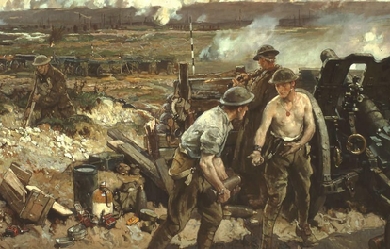
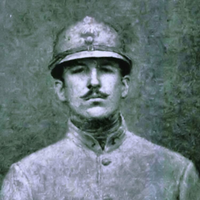
Alan Seeger (22 June 1888– 4 July 1916) was an American poet who fought and died in World War I during the Battle of the Somme serving in the French Foreign Legion. Seeger was the uncle of American folk singer Pete Seeger, and was a classmate of T.S. Eliot at Harvard. He is most well known for having authored the poem, I Have a Rendezvous with Death, a favorite of President John F. Kennedy. A statue modeled after Seeger is found on the monument honoring fallen Americans who volunteered for France during the war, located at the Place des États-Unis, Paris. He is sometimes called the “American Rupert Brooke.” Early life Born in New York on June 22, 1888, Seeger moved with his family to Staten Island at the age of one and remained there until the age of 10. In 1900, his family moved to Mexico for two years, which influenced the imagery of some of his poetry. His brother Charles Seeger, a noted pacifist and musicologist, was the father of the American folk singers Peter “Pete” Seeger, Mike Seeger, and Margaret “Peggy” Seeger. Seeger entered Harvard in 1906 after attending several elite preparatory schools, including Hackley School. Writing At Harvard, he edited and wrote for the Harvard Monthly. Among his friends there (and afterward) was the American Communist John Reed, though the two had differing ideological views, and his Harvard class also included T.S. Eliot and Walter Lippmann, among others. After graduating in 1910, he moved to Greenwich Village for two years, where he wrote poetry and enjoyed the life of a young bohemian. During his time in Greenwich Village, he attended soirées at the Mlles. Petitpas’ boardinghouse (319 West 29th Street), where the presiding genius was the artist and sage John Butler Yeats, father of the poet William Butler Yeats. Having moved to the Latin Quarter of Paris to continue his seemingly itinerant intellectual lifestyle, on August 24, 1914, Seeger joined the French Foreign Legion so that he could fight for the Allies in World War I (the United States did not enter the war until 1917). Death He was killed in action at Belloy-en-Santerre on July 4, 1916, famously cheering on his fellow soldiers in a successful charge after being hit several times by machine gun fire. Poetry Seeger’s poetry was published by Charles Scribner’s Sons in December 1916 with a 46-page introduction by William Archer. Poems, a collection of his works, was relatively unsuccessful, due, according to Eric Homberger, to its lofty idealism and language, qualities out of fashion in the early decades of the 20th century. Poems was reviewed in The Egoist, where the critic—T. S. Eliot, Seeger’s classmate at Harvard—commented that, Seeger was serious about his work and spent pains over it. The work is well done, and so much out of date as to be almost a positive quality. It is high-flown, heavily decorated and solemn, but its solemnity is thorough going, not a mere literary formality. Alan Seeger, as one who knew him can attest, lived his whole life on this plane, with impeccable poetic dignity; everything about him was in keeping. One of his more famous poems was I Have a Rendezvous with Death, published posthumously. A recurrent theme in both his poetic works and his personal writings was his desire for his life to end gloriously at an early age. This particular poem, according to the JFK Library, “was one of John F. Kennedy’s favorite poems and he often asked his wife (Jacqueline) to recite it.” Memorials On 4 July 1923, the President of the French Council of State, Raymond Poincaré, dedicated a monument in the Place des États-Unis to the Americans who had volunteered to fight in World War I in the service of France. The monument, in the form of a bronze statue on a plinth, executed by Jean Boucher, had been financed through a public subscription. Boucher had used a photograph of Seeger as his inspiration, and Seeger’s name can be found, among those of 23 others who had fallen in the ranks of the French Foreign Legion, on the back of the plinth. Also, on either side of the base of the statue, are two excerpts from Seeger’s “Ode in Memory of the American Volunteers Fallen for France”, a poem written shortly before his death on 4 July 1916. Seeger intended that his words should be read in Paris on 30 May of that year, at an observance of the American holiday, Decoration Day (later known as Memorial Day): They did not pursue worldly rewards; they wanted nothing more than to live without regret, brothers pledged to the honor implicit in living one’s own life and dying one’s own death. Hail, brothers! Goodbye to you, the exalted dead! To you, we owe two debts of gratitude forever: the glory of having died for France, and the homage due to you in our memories. Alan Seeger Natural Area, in central Pennsylvania, was named by Colonel Henry Shoemaker. It is unknown if Alan Seeger had any connection to the area or why Shoemaker chose to memorialize the poet. The area is known for its virgin trees. References Wikipedia—https://en.wikipedia.org/wiki/Alan_Seeger


